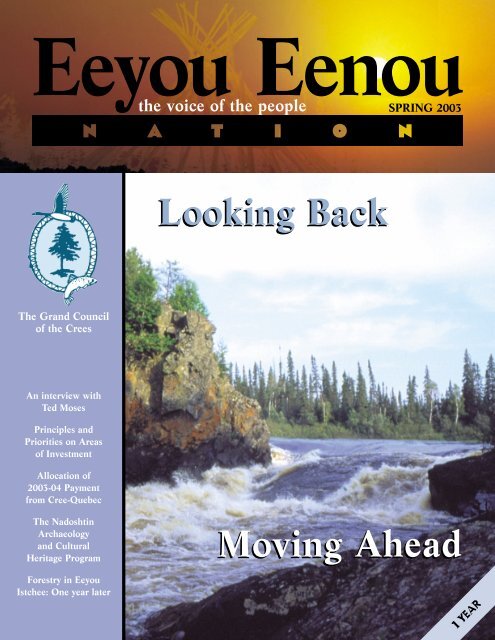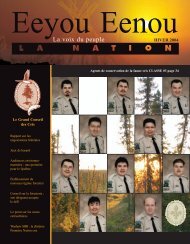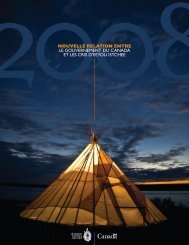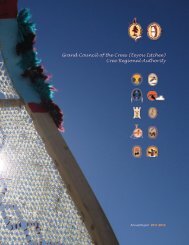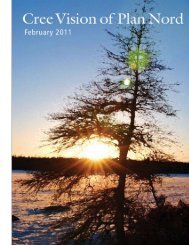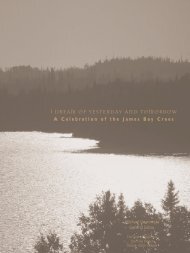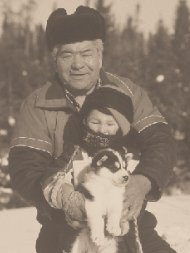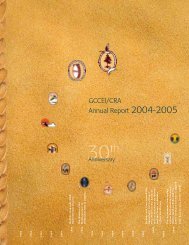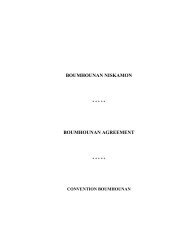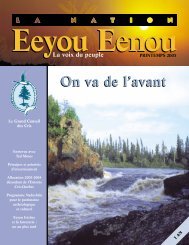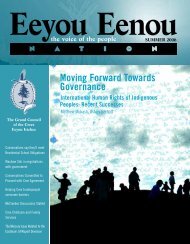Looking Back Moving Ahead - The Grand Council of the Crees
Looking Back Moving Ahead - The Grand Council of the Crees
Looking Back Moving Ahead - The Grand Council of the Crees
- No tags were found...
Create successful ePaper yourself
Turn your PDF publications into a flip-book with our unique Google optimized e-Paper software.
Eeyou EenouSPRING 2003<strong>the</strong> voice <strong>of</strong> <strong>the</strong> people<strong>Looking</strong> <strong>Back</strong><strong>The</strong> <strong>Grand</strong> <strong>Council</strong><strong>of</strong> <strong>the</strong> <strong>Crees</strong>An interview withTed MosesPrinciples andPriorities on Areas<strong>of</strong> InvestmentAllocation <strong>of</strong>2003-04 Paymentfrom Cree-Quebec<strong>The</strong> NadoshtinArchaeologyand CulturalHeritage ProgramForestry in EeyouIstchee: One year later<strong>Moving</strong> <strong>Ahead</strong>1 YEAR
<strong>The</strong> mandate <strong>of</strong> <strong>the</strong> <strong>Grand</strong> <strong>Council</strong><strong>of</strong> <strong>the</strong> <strong>Crees</strong> (Eeyou Istchee)<strong>The</strong> <strong>Grand</strong> <strong>Council</strong> <strong>of</strong> <strong>the</strong> <strong>Crees</strong> (GCCEI) is <strong>the</strong> political voice <strong>of</strong><strong>the</strong> Cree people who live in <strong>the</strong> province <strong>of</strong> Quebec, Canada. Our<strong>Council</strong>, established in 1974, represents <strong>the</strong> nine Cree communitieswhose lands and traditional way <strong>of</strong> life were threatened by <strong>the</strong>construction <strong>of</strong> <strong>the</strong> James Bay hydroelectric development projectin <strong>the</strong> northwestern portion <strong>of</strong> <strong>the</strong> province. Today <strong>the</strong> <strong>Grand</strong><strong>Council</strong> continues working to promote and protect <strong>the</strong> rights <strong>of</strong><strong>the</strong> Cree Nation.A Messagefrom <strong>the</strong> Editor,Bill NamagoosePlease sendcorrespondence to:Bill Namagoose, EditorEeyou Eenou NationEmbassy <strong>of</strong> <strong>the</strong> Cree Nation81 Metcalfe Street, Suite 900Ottawa, Ontario K1P 6K7or by e-mail:billnama@gcc.caTo read <strong>the</strong> New Agreement on <strong>the</strong>Internet see: http://www.gcc.caPlease send feedback to:E-mail: cree@gcc.caCree Regional Authority2 Lakeshore Rd.Nemaska QC J0Y 3B0Photos by Fred Cattroll© Reproduction is prohibited without written permission<strong>of</strong> <strong>the</strong> Editor.Table <strong>of</strong> Contents5 Board <strong>of</strong> Directors 20036-13 An Interview with Ted Moses14 Principles and Priorities on Areas <strong>of</strong> Investment15-16 Allocation <strong>of</strong> 2003–2004 Payment from Cree-Quebec17 Establishing a Financial Foundation for <strong>the</strong> Future18-19 Mistissini Lodge Prepares to Welcome Visitors20-30 <strong>The</strong> Nadoshtin Archaeology and CulturalHeritage Program31-36 Forestry in Eeyou Istchee: One Year Later37 <strong>The</strong> Kanak Visit38 New Protected Areas for Waskaganish Territory39-41 Boumhounan—One year later42-43 Weh-Sees Indohoun and Ad-Hoc Committee44-45 Vocational Training Centre to be Built in Waswanipi46 <strong>The</strong> Troilus Agreement47 Exercise and Healthy Eating: Solutions toChildhood ObesityIt was interesting to see our <strong>Grand</strong> Chief’s appearance at<strong>the</strong> Cree/Naskapi Commission in February. <strong>The</strong> main issuewas <strong>the</strong> comments made by Indian and Nor<strong>the</strong>rn AffairsCanada (INAC) in <strong>the</strong>ir presentation to <strong>the</strong> Commissionlast year concerning <strong>the</strong> financial health <strong>of</strong> <strong>the</strong> CreeCommunities and <strong>of</strong> <strong>the</strong> <strong>Grand</strong> <strong>Council</strong>/CRA.Besides having made false allegations, what wasparticularly shocking was that <strong>the</strong> Departmenthad apparently not even read many <strong>of</strong> <strong>the</strong> auditedfinancial statements that we had submitted to it!Indian and Nor<strong>the</strong>rn Affairs Canada is proposingnew legislation to impose increased accountabilitystandards on First Nations across Canada and couldnot even keep up with <strong>the</strong> 10 audit reports that<strong>the</strong>y had received from <strong>the</strong> <strong>Crees</strong>. <strong>The</strong> proposedchanges to <strong>the</strong> Indian Act do not apply to <strong>the</strong> <strong>Crees</strong>because we already have a strong accountabilitysection that we negotiated for with Canada in <strong>the</strong>Cree/Naskapi Act in 1984.However, what is apparent from our experienceis that Indian and Nor<strong>the</strong>rn Affairs Canada, <strong>the</strong>Government <strong>of</strong> Canada, is as <strong>Grand</strong> Chief Mosesstated, “not ready for self-government.” Yet <strong>the</strong>Department’s communications spin doctors havemanaged to convince <strong>the</strong> Canadian public thatAboriginal Nations aren’t ready.<strong>The</strong> Cree/Naskapi Act is also flawed. Canadainsisted in <strong>the</strong> Cree/Naskapi Act that if a band hadfinancial problems, <strong>the</strong> Minister <strong>of</strong> Indian Affairsand Nor<strong>the</strong>rn Development could come in, seize<strong>the</strong> operations <strong>of</strong> <strong>the</strong> Band and appoint a thirdparty from an outside accounting firm to run <strong>the</strong>community. Yes, <strong>the</strong>re are time delays during which<strong>the</strong> band can try to get its house in order and <strong>the</strong>reare notices that INAC has to send first, but it isbasically a “get out <strong>of</strong> <strong>the</strong> way Indian, <strong>the</strong> IndianAgent is back” type <strong>of</strong> approach to “supporting”our Cree local governments. I don’t buy it.<strong>The</strong> Cree Nation has moved beyond those days. Itis time that we pushed <strong>the</strong> Government <strong>of</strong> Canadato amend <strong>the</strong> Cree/Naskapi Act to remove thoseprovisions. <strong>The</strong> fact is that over <strong>the</strong> years Canadahas controlled <strong>the</strong> over 600 First Nations under<strong>the</strong> Indian Act by dealing with <strong>the</strong>m individuallyand in a high-handed manner. INAC doles out alittle money to <strong>the</strong> good Indians and punishes whatit considers <strong>the</strong> bad ones by cutting <strong>the</strong> fundingand by taking over <strong>the</strong>ir operations. <strong>The</strong>re is littleincentive for First Nations to work toge<strong>the</strong>r becauseeveryone is beholden to INAC. In fact, it is morethan this; First Nations <strong>of</strong>ten jealously guard <strong>the</strong>ir“contacts” with <strong>the</strong> Minister so <strong>the</strong>y can beg for alittle more money than what <strong>the</strong>ir neighbour goton some program or ano<strong>the</strong>r. <strong>The</strong>y seek advantageagainst one ano<strong>the</strong>r.This is <strong>of</strong>ten how <strong>the</strong>y are controlled, <strong>the</strong>Minister gives out a little money here and <strong>the</strong>reso he feels good, he has a few Chiefs for friends,but <strong>the</strong> real problems are never addressed.Housing and community infrastructure continueto be inadequately funded, Aboriginal Peoplescontinue to be unemployed while <strong>the</strong> resources3
4are exploited to benefit <strong>the</strong> non-aboriginalcommunities around <strong>the</strong>m. <strong>The</strong> question <strong>of</strong>standards is never addressed. In fact, under thissystem Aboriginal Peoples are blamed and insome cases blame <strong>the</strong>mselves for <strong>the</strong>ir poverty.<strong>The</strong> truth is that Canada is following a policy<strong>of</strong> promoting <strong>the</strong> status quo where AboriginalPeoples are always <strong>of</strong>f-balance, always unemployedand living in poverty, never recognized and foreveralone and dependent on Indian and Nor<strong>the</strong>rn AffairsCanada. Canada’s policy has been <strong>the</strong> cause <strong>of</strong> <strong>the</strong>loss <strong>of</strong> languages and ways <strong>of</strong> life and seems to bedesigned to wait until most <strong>of</strong> <strong>the</strong> more than 600First Nations disappear.<strong>The</strong> alternative is something that <strong>the</strong> <strong>Crees</strong>have gone part <strong>of</strong> <strong>the</strong> way in realizing. In 1975,we signed <strong>the</strong> James Bay Agreement not justas separate bands, but also as “<strong>The</strong> <strong>Crees</strong>,”organized toge<strong>the</strong>r as <strong>The</strong> <strong>Grand</strong> <strong>Council</strong> <strong>of</strong> <strong>the</strong><strong>Crees</strong>. At <strong>the</strong> time, <strong>the</strong> governments <strong>of</strong> Canadaand Quebec refused to recognize Cree NationGovernment in <strong>the</strong> Agreement, but we stilldecided and stood as a Nation by making <strong>the</strong><strong>Grand</strong> <strong>Council</strong> <strong>the</strong> protector <strong>of</strong> <strong>the</strong> rights <strong>of</strong> all<strong>Crees</strong>. You will see in <strong>the</strong> James Bay Agreementthat Cree government is only referred to as “<strong>The</strong>Cree Regional Authority.” In <strong>the</strong> 1970s whenQuebec passed its legislation to recognize <strong>the</strong>powers <strong>of</strong> <strong>the</strong> CRA as set out in <strong>the</strong> James Bayand Nor<strong>the</strong>rn Quebec Agreement, we managed toget <strong>the</strong>m to include <strong>the</strong> Cree words for it: “EeyouTabeytachesiw” and you know what that means,“Cree Government”, <strong>the</strong> words that <strong>the</strong>y wouldnot accept in <strong>the</strong>ir own language.After almost 30 years <strong>of</strong> fighting for <strong>the</strong> recognitionand acknowledgement <strong>of</strong> our rights, last year wesigned an agreement with Quebec on a Nation-to-Nation basis and in that new Agreement we tookover many obligations for community and economicdevelopment that Quebec formerly had to <strong>the</strong><strong>Crees</strong> in <strong>the</strong> James Bay Agreement, but had neverimplemented. To some extent, it was our speakingout in Johannesburg, where we said that our rightto self-determination had been violated, that wewere excluded from <strong>the</strong> economy <strong>of</strong> our territoryand that we did not have enough housing for ourpeople, that caught Quebec’s attention. <strong>The</strong> <strong>Crees</strong>have needs like any People and we have <strong>the</strong> rightto participate in <strong>the</strong> benefits from <strong>the</strong> development<strong>of</strong> <strong>the</strong> resources on our traditional territory,forget about category 1, 2 and 3 lands, it is allEeyou Istchee.However, Canada is still in denial <strong>of</strong> <strong>the</strong> rights <strong>of</strong>Aboriginal Peoples, including Cree rights. Whilewe have managed to get some acknowledgement <strong>of</strong>our existence as a People, through <strong>the</strong> signature by<strong>the</strong> <strong>Grand</strong> <strong>Council</strong> on <strong>the</strong> James Bay Agreement,Canada has yet to recognize and acknowledge <strong>the</strong>Cree Nation Government in all <strong>of</strong> its aspects.Cree Nation Government should adopt standardsfor housing, employment and for Cree rights sothat all <strong>Crees</strong> can strive to have equal opportunityand access to <strong>the</strong> means to help <strong>the</strong>mselves. Everyfamily needs a house. We need a nation governmentthat helps <strong>the</strong> band administrators, treasurers,firefighters, police, economic development <strong>of</strong>ficersand environment managers to do <strong>the</strong>ir jobs inways that are more effective in serving <strong>the</strong> people.We need to work toge<strong>the</strong>r because we serve <strong>the</strong>Cree People.By working toge<strong>the</strong>r on a national basis, all <strong>of</strong><strong>the</strong>se will find ways to make sure that all <strong>Crees</strong>get access to programs that provide <strong>the</strong>m wi<strong>the</strong>quality <strong>of</strong> service. If we have problems, weshould sort <strong>the</strong>m out ourselves and if one <strong>of</strong>our communities needs more resources, <strong>the</strong>nwe should work toge<strong>the</strong>r to help <strong>the</strong>m. Over <strong>the</strong>years we have accomplished much toge<strong>the</strong>r as<strong>the</strong> Cree Nation. It is time that we built <strong>the</strong> CreeNation Government so that we can keep Indianand Nor<strong>the</strong>rn Affairs Canada out <strong>of</strong> our businessand get on with <strong>the</strong> job <strong>of</strong> improving <strong>the</strong> lives <strong>of</strong>our people. Canada must accept a relationshipwith <strong>the</strong> <strong>Crees</strong> where we are recognized andacknowledged as <strong>the</strong> Cree Nation, as <strong>the</strong> CreePeople and as a permanent and growing part <strong>of</strong><strong>the</strong> political and social landscape.Board <strong>of</strong> Directors 2003CRA MONTRÉAL<strong>Grand</strong> Chief Ted MosesT – (514) 861-5837F – (514) 861-0760CRA NEMASKADeputy <strong>Grand</strong> ChiefPaul GullT – (819) 673-2600F – (819) 673-2606CHISASIBIChief Abraham RupertSteve BearskinT – (819) 855-2878F – (819) 855-2875EASTMAINChief Edward Gilpin Jr.Kenneth GilpinT – (819) 977-0211F – (819) 977-0281MISTISSINIChief John LongchapThomas NeeposhT – (418) 923-3461F – (418) 923-3115 or -3625NEMASKAChief Josie JimikenThomas Jolly Sr.T – (819) 673-2512F – (819) 673-2542OUJE-BOUGOUMOUChief Sam R. BosomKenny MianscumT – (819) 745-3911F – (819) 745-3426 or -3168WASKAGANISHChief Robert WeistcheBilly DiamondT – (819) 895-8650F – (819) 895-8901WASWANIPIChief Robert KitchenRhonda OblinT – (819) 753-2587F – (819) 753-2555WEMINDJIChief Reggie MarkDanny TomatukT – (819) 978-0264F – (819) 978-0258WHAPMAGOOSTUIChief David MastyLosty MamianskumT – (819) 929-3384F – (819) 929-3203 or -3969GCCEI OTTAWABill NamagooseT – (613) 761-1655F – (613) 761-1388CRA NEMASKAEddie DiamondMat<strong>the</strong>w SwallowWillie Iserh<strong>of</strong>fT – (819) 673-2600F – (819) 673-2606CNYD NEMASKAAndrew NeeposhT – (819) 673-2600F – (819) 673-2606CHRD MISTISSINIHenry MianscumT – (819) 923-2525F – (819) 923-2111MONTRÉALNorman Gull, CSAT – (819) 866-1234F – (819) 866-1331MONTRÉALCorporate SecretaryJohn Paul MurdochT – (514) 878-9641F – (514) 878-14505Eeyou Eenou Nation: Spring 2003
An Interview with Ted MosesLa Paix des Braves is working. It has been over a year since it was signed. Since <strong>the</strong>n hundreds <strong>of</strong> Cree jobshave been created and local development is flourishing. Exciting new projects are being undertaken in many<strong>of</strong> <strong>the</strong> Communities. Mistissini is in final stages <strong>of</strong> completing its hotel, Ouje-Bougoumou is about to open astate-<strong>of</strong> <strong>the</strong>-art athletic complex, <strong>the</strong> regional training center in Waswanipi has been announced, <strong>the</strong>re are plansfor a new Band <strong>of</strong>fice in Waskaganish, Wemindji and Nemaska are going to build more houses and Chisasibihas a new youth center and is building a new Band Office. Eastmain and Whapmagoostui are planning howto use <strong>the</strong> funding received this year. Every Cree community has projects underway or being planned.6“ Forestry remainsa difficult issue,even with <strong>the</strong> newregime. However,for <strong>the</strong> first timewe have a freeand open dialoguewith Quebec and<strong>the</strong> companies onprotecting some<strong>of</strong> <strong>the</strong> forest …“Local housing in all <strong>the</strong> Cree communities has received a vital boost. Some <strong>of</strong><strong>the</strong> longest-standing problems regarding crowded and rundown shelter in <strong>the</strong>communities are finally beginning to be resolved. Indeed, <strong>the</strong> leadership hasmade housing and infrastructure a priority issue.<strong>The</strong> Cree Trappers Association is finally beginning to catch up on its funding,with <strong>the</strong> result that <strong>the</strong> trappers are finally starting to receive benefits that werepromised in 1975. It will now be up to <strong>the</strong> <strong>Crees</strong> to decide how much to pay to <strong>the</strong>CTA with respect to Quebec’s past obligations under <strong>the</strong> James Bay Agreement.So <strong>the</strong> good news is that La Paix des Braves is helping <strong>the</strong> Cree communitiesand <strong>the</strong> Cree Nation in clear and important ways.<strong>The</strong> new regimes for forestry and mining have begun <strong>the</strong>ir work. <strong>The</strong> CreeMineral Exploration Board has been established and is beginning its work.Existing and developing Cree mining enterprises now have access to financialresources and expertise to assist <strong>the</strong>m in taking full advantage <strong>of</strong> miningopportunities in Eeyou Istchee.Forestry remains a difficult issue, even with <strong>the</strong> new regime. However, for <strong>the</strong>first time we have a free and open dialogue with Quebec and <strong>the</strong> companies onprotecting some <strong>of</strong> <strong>the</strong> forest, so that Cree hunting can continue. Not everyoneis happy with <strong>the</strong> new regime. Some <strong>of</strong> <strong>the</strong> forestry companies complain that<strong>the</strong>y are losing wood volume and that <strong>the</strong> Paix des Braves is threatening forestryjobs. Some <strong>Crees</strong> are not satisfied because <strong>the</strong>y have yet to witness change on<strong>the</strong> land. O<strong>the</strong>rs have expressed frustration because discussions are going tooslowly and <strong>the</strong> promised Cree/Quebec Forestry Board is still not up and running.<strong>The</strong>se are legitimate causes for concern. We must take a strong stand on forestryand not allow <strong>the</strong> gains that we have made to be undermined by those whowould blame us for job losses. We must not allow ourselves to be held responsiblefor years <strong>of</strong> mismanagement and over harvesting by <strong>the</strong> forestry industry.<strong>The</strong> forestry provisions in <strong>the</strong> Paix des Braves have finally brought sustainabilityto an industry that was marching toward a wood supply disaster. It is up to usto remain firm and use <strong>the</strong> regime to improve on <strong>the</strong> way <strong>the</strong> forest has beencut in <strong>the</strong> past. If forestry is properly managed in <strong>the</strong> future, it will bring longterm employment and development benefits for <strong>the</strong> region.A long term vision for <strong>the</strong> future is something that <strong>the</strong> <strong>Crees</strong> have been voicingsince <strong>the</strong> days when we were eight isolated communities that no one in Quebechad ever heard <strong>of</strong>. Now that vision is helping shape <strong>the</strong> course <strong>of</strong> <strong>the</strong> entire“We must remind<strong>the</strong>se people andany politician whothinks <strong>the</strong> <strong>Crees</strong>have forfeited<strong>the</strong>ir rights that<strong>the</strong> Paix des Bravesis a Nation toNation Agreement,not based onsurrender, but basedon our rights andon cooperation andmutual respect …”province. We were <strong>the</strong> people who warned <strong>of</strong> <strong>the</strong> dangers <strong>of</strong> Great Whaleand <strong>the</strong> NBR projects. And <strong>the</strong> same goes for forestry. Our determinationas a Nation continues to play an important role in shaping <strong>the</strong> long termvision, not only for Eeyou Istchee but for <strong>the</strong> entire province.<strong>The</strong> sad thing is that, despite all our efforts over <strong>the</strong> years, <strong>the</strong>re are still thosewho criticize us for having <strong>the</strong> courage to sign <strong>the</strong> Paix des Braves—<strong>the</strong>courage to accept EM1A over NBR, to accept 350 square kilometers <strong>of</strong>flooding versus 6500 square kilometres. We made <strong>the</strong> decision and <strong>the</strong>Paix des Braves is based on <strong>the</strong> fact that future development requires ourconsent. It is <strong>the</strong>se people who falsely state that this is not true. When <strong>the</strong>yheard Quebec politicians in <strong>the</strong> election talking about <strong>the</strong> Great WhaleProject, <strong>the</strong>se <strong>Crees</strong> turned and criticized <strong>the</strong>ir own people ra<strong>the</strong>r thanattacking <strong>the</strong> views <strong>of</strong> those politicians. I opposed <strong>the</strong> project, as <strong>the</strong> peoplehad already decided, and stated so publicly.We must remind <strong>the</strong>se people and any politician who thinks <strong>the</strong> <strong>Crees</strong>have forfeited <strong>the</strong>ir rights that <strong>the</strong> Paix des Braves is a Nation to NationAgreement, not based on surrender, but based on our rights and on cooperationand mutual respect in our relations with Quebec. That is, cooperationand respect from Quebec for <strong>the</strong> <strong>Crees</strong> and <strong>the</strong> same from <strong>the</strong> <strong>Crees</strong>to Quebec. Our position on Great Whale remains as clear as it was at <strong>the</strong>historic Special General Assembly in 1989. We will not consent to a projectthat floods over 3000 square kilometers and destroys 4 larger rivers. Thosewho think o<strong>the</strong>rwise risk repeating history.Curiously, those people who really care about <strong>the</strong> environment areastounded to learn what we have accomplished for <strong>the</strong> environment andfor Eeyou Istchee through La Paix des Braves in just one short year. Despitepopular misconception, <strong>the</strong>y are surprised to learn that <strong>the</strong> new forestryregime has resulted in <strong>the</strong> closure <strong>of</strong> several Cree hunting territories to activelogging. <strong>The</strong>y are surprised to learn that through our new partnership withQuebec, 6 new protected areas have been created in Eeyou Istchee. <strong>The</strong>ywonder why we do not hear more about this from <strong>the</strong> opposition partiesin Quebec and from those who support <strong>the</strong> environment in <strong>the</strong> Cree camp.<strong>The</strong>y wonder why <strong>the</strong>se issues are not covered in <strong>the</strong> media.I believe it is because people find it difficult to accept that <strong>the</strong> <strong>Crees</strong> canhave it both ways. That development, that benefits both <strong>the</strong> <strong>Crees</strong> and7Eeyou Eenou Nation: Spring 2003
8Quebecers, can be tempered with a sustainablelong term vision. For <strong>the</strong> truth, ask <strong>the</strong> trappersand those who earn <strong>the</strong>ir livelihoods from all <strong>the</strong>increased employment and activity created by LaPaix des Braves. Ask someone who enjoys <strong>the</strong> lifein <strong>the</strong> bush as hard as it sometimes is. Ask <strong>the</strong> CreeTrappers Association. Ask those who still live <strong>the</strong>traditional way <strong>of</strong> life. La Paix des Braves is workingfor <strong>the</strong>m. Ask those who have new jobs. Ask <strong>the</strong>people who are receiving training. Ask <strong>the</strong> majority<strong>of</strong> <strong>the</strong> <strong>Crees</strong> who voted to approve <strong>the</strong> agreement.<strong>The</strong> debate on La Paix des Braves is over.<strong>The</strong>re will still be discussions and hearings involving<strong>the</strong> environmental and social impacts according to<strong>the</strong> James Bay and Nor<strong>the</strong>rn Quebec Agreement. All<strong>of</strong> those regulations will continue to apply. <strong>The</strong>ywill now determine whe<strong>the</strong>r <strong>the</strong> EM1A-RupertProject goes ahead or not.But also, let’s not ignore <strong>the</strong> vastly improved relationsbetween <strong>the</strong> Cree Nation and <strong>the</strong> Government <strong>of</strong>Quebec. Let’s not ignore all <strong>of</strong> <strong>the</strong> agreements,<strong>the</strong> ease <strong>of</strong> doing business, <strong>the</strong> hugely increasedeconomic opportunities that have emerged, and<strong>the</strong> pleasure <strong>of</strong> working with a government thatlistens to and hears <strong>the</strong> <strong>Crees</strong>.La Paix des Braves is having a huge impact internationallybecause it is <strong>the</strong> first agreement thatactually recognizes aboriginal peoples’ right tobenefit from <strong>the</strong>ir own resources. It is also <strong>the</strong> firstagreement that implements a major recommendation<strong>of</strong> Canada’s Royal Commission on AboriginalPeoples, that we have access to more benefits fromresource development. It is <strong>the</strong> first agreement tobring aboriginal peoples into <strong>the</strong> larger economy.It is <strong>the</strong> first agreement to provide <strong>the</strong> beginnings<strong>of</strong> an economic base for <strong>the</strong> development <strong>of</strong> <strong>the</strong>economy <strong>of</strong> an aboriginal nation.I welcome any questions about La Paix des Braves,but let’s not hide <strong>the</strong> facts. Let’s acknowledge whatwe all accomplished by deciding to accept <strong>the</strong> NewAgreement. Let’s admit that <strong>the</strong>se are things we havebeen struggling for years to obtain. Let’s acknowledge<strong>the</strong> cancellation <strong>of</strong> NBR and its six thousandfive hundred square kilometers <strong>of</strong> reservoirs. Let’sacknowledge <strong>the</strong> changes in <strong>the</strong> forest regime thatsave more <strong>of</strong> <strong>the</strong> forest. Let’s acknowledge thatwe are part <strong>of</strong> <strong>the</strong> management <strong>of</strong> <strong>the</strong> Territorialresources and are no longer marginalized andexcluded from <strong>the</strong>se decisions. Let’s acknowledgethat our rights are being respected. Let’s acknowledgeour win for <strong>the</strong> Cree Nation, for <strong>the</strong> environment,and for <strong>the</strong> Cree way <strong>of</strong> life.This is what we have now begun with Quebec. Itis what we thought we had accomplished in 1975but now we have commitments on <strong>the</strong> details <strong>of</strong>how we are involved and we have <strong>the</strong> means toenforce our rights if ever again <strong>the</strong>y are ignored.<strong>The</strong>re are those who seek to seize <strong>the</strong> territory,exclude o<strong>the</strong>rs and stop development. In <strong>the</strong>irfierce opposition, whe<strong>the</strong>r <strong>the</strong>y know it or not,<strong>the</strong>se people will give <strong>the</strong>ir opponents <strong>the</strong> excuseto use violence. <strong>The</strong>re is a time for opposition and<strong>the</strong>re is a time for agreement. Those who seekextreme solutions risk spending <strong>the</strong>ir lives on roadblocks. We must choose a future for our people,one built on peaceful means. Education, employment,housing, community facilities and new Creecompanies, <strong>the</strong>se are what we need. This is part <strong>of</strong>building our Cree Nation. – Meegwetch!!9Eeyou Eenou Nation: Spring 2003
1011Eeyou Eenou Nation: Spring 2003
1213Eeyou Eenou Nation: Spring 2003
Principles and Prioritieson Areas <strong>of</strong> InvestmentLa Paix des Braves FundsAllocation <strong>of</strong> 2003–2004Payment from Cree-QuebecNew Relationship AgreementAllocation <strong>of</strong> <strong>the</strong> 2003–2004 payment from <strong>the</strong> Cree Quebec New Relationship Agreement—La Paix des Braves.14<strong>The</strong> Limited Partnership meeting <strong>of</strong> March 26, 2003 resolved that <strong>the</strong> allocation <strong>of</strong> <strong>the</strong> 2003–2004 paymentfrom La Paix des Braves will be allocated on <strong>the</strong> following basis. <strong>The</strong> community allocation <strong>of</strong> $36,500,000is based on a compromise by <strong>the</strong> local Cree leadership.1. Future GenerationsThis investment was resolved when <strong>the</strong> JointPartnership <strong>of</strong> <strong>the</strong> Cree Boards and <strong>the</strong> <strong>Grand</strong><strong>Council</strong> adopted a bylaw to set aside and invest15 percent <strong>of</strong> <strong>the</strong> funds from Quebec starting inyear three. Discipline is required to ensure thatwe adhere to <strong>the</strong> mission to create and manage<strong>the</strong> fund whose revenues in <strong>the</strong> final year <strong>of</strong> LaPaix des Braves will be equal or greater than <strong>the</strong>payments from Quebec.2. Economic DevelopmentThis investment’s main priority would be to createjobs. <strong>The</strong> allocation could be <strong>the</strong> same as <strong>the</strong> Board<strong>of</strong> Compensation formula Community Fund that isbased on per capita. <strong>The</strong> four small communitiesget <strong>the</strong> first 5 percent and that balance is dividedon per capita.3. Community DevelopmentThis investment would be based on need. <strong>The</strong> housingbacklog would be used to allocate this portionon a prorated basis. <strong>The</strong>se projects are for shelter aswell as o<strong>the</strong>r community infrastructure and facilities.4. JBNQA/La Paix des Braves Legal ObligationsThis investment would cover <strong>the</strong> expensesrequired to implement Quebec’s Section 28 JBNQAobligations that were transferred to <strong>the</strong> Cree Nationin La Paix des Braves. <strong>The</strong>se obligations are:Responsibilities <strong>of</strong> SODAB, Cree Trappers Assoc.,Cree Outfitting and Tourism Assoc., Cree NativeArts and Crafts Assoc., Training Courses andPlacement, Community Centres, EssentialSanitation Services, Fire Protection, Assistanceto Cree Entrepreneurs.5. Loans and Debts<strong>The</strong> <strong>Crees</strong> have incurred loans and debts over <strong>the</strong>years in trying to get <strong>the</strong> Quebec government torespect its obligations and interim measures in <strong>the</strong>forestry areas. <strong>The</strong>se loans and debts are owed to<strong>the</strong> Board <strong>of</strong> Compensation and James Bay Eeyou.6. Overhead Costs to ImplementLa Paix des Braves/JBNQA<strong>The</strong> costs to implement and enforce La Paix desBraves such as Standing Liaison committee, LimitedPartnership expenses, various committees expenses,Cree Mineral Board and Forestry Regime.7. Enforcement <strong>of</strong> Cree Rights<strong>The</strong> Board <strong>of</strong> Compensation’s (BOC) past expendituresto highlight and protect Cree Rights in manyareas have provided <strong>the</strong> most beneficial return to<strong>the</strong> Cree Nation. <strong>The</strong> Cree Nation still needs to applypressure against <strong>the</strong> federal government to force itto fulfill its obligations in <strong>the</strong> JBNQA.8. Leveraging Additional Revenue from Quebec,Federal or O<strong>the</strong>r Source <strong>of</strong> FundsNeed to invest in areas <strong>of</strong> joint Quebec and federalJBNQA obligations in order to increase <strong>the</strong> federalfunding that would normally be available. O<strong>the</strong>rinvestments that will generate additional revenuefor <strong>the</strong> Cree Nation, such as federal or Quebecprograms that require applicants to provide afinancial contribution, will be a priority.<strong>The</strong>se funds will go to shelter and economic development programs.<strong>The</strong> allocation <strong>of</strong> $9,500,000 is not finalized and is intended to cover <strong>the</strong> items listed. This amount will beallocated by <strong>the</strong> GCCEI/CRA.<strong>The</strong> Limited Partnership is <strong>the</strong> Recipient <strong>of</strong> Funding preferred to <strong>the</strong> Cree Quebec New RelationshipAgreement commonly known as La Paix des Braves.Allocation to Cree CommunitiesPartnership Final Approved Allocationpop pop%3302 24% Chisasibi 7,300,000 20%580 4% Eastmain 2,350,000 6%2951 21% Mistissini 8,000,000 22%617 4% Nemaska 2,000,000 5%628 5% Ouje-Bougoumou 2,000,000 5%2127 15% Waskaganish 4,000,000 11%1590 12% Waswanipi 5,000,000 14%1183 9% Wemindji 3,500,000 10%755 5% Whapmagoostui 2,350,000 6%13,733 36,500,000Cree Communities 36,500,000 80%Allocated to o<strong>the</strong>r obligations 9,500,000 20%Total allocation for 2003–2004 46,000,00015Eeyou Eenou Nation: Spring 2003
La Paix des BravesLoans and Debt AllocationAmountEstablishing a FinancialFoundation for <strong>the</strong> Future<strong>The</strong> Cree Nation has taken an important step towards establishing a financial foundation for <strong>the</strong> future asa result <strong>of</strong> <strong>the</strong> decision to contribute a share <strong>of</strong> <strong>the</strong> annual funding to be provided pursuant to <strong>the</strong> NewRelationship Agreement with Quebec to <strong>the</strong> new Waayapisinigan Fund.An annual obligatory contribution <strong>of</strong> 15% <strong>of</strong> Quebec’s contribution to <strong>the</strong> Cree Nation shall be set asidein <strong>the</strong> Waayapisinigan Fund as <strong>of</strong> April 1, 2004.16GCC (EI) – Negotiation Costs (Unfunded balance <strong>of</strong> deficit, March 31, 2002)GCC (EI) – Balance <strong>of</strong> Funding Requirement for 2002-2003 (Current estimate)Board <strong>of</strong> Compensation – Forestry Loan (Balance to be repaid)JBEC – Trapper’s Assistance Program Loan – Principle PortionJBEC – Trapper’s Assistance Program Loan – Projected Accrued Interest CostsJBEC – EM1 Negotiations and Litigation (1996)Commitments/Undertakings Relating to AgreementCree Quebec Forestry BoardO<strong>the</strong>r Forestry Related ExpendituresTBDTBDTBDTBDTBDTBDTBDTBD<strong>The</strong> Waayapisinigan Fund will grow over <strong>the</strong> life <strong>of</strong> <strong>the</strong> Agreement with Quebec as <strong>the</strong> annual contributionsand all income derived by <strong>the</strong> fund cannot be distributed for <strong>the</strong> first 50 years. <strong>The</strong> fund will be pr<strong>of</strong>essionallymanaged similar to a Pension Fund and shall be subject to very strict investment and management rules.<strong>The</strong> contribution level <strong>of</strong> 15% was determined as <strong>the</strong> required contribution to ensure that <strong>the</strong> fundwould generate as <strong>of</strong> April 2052 a sustainable revenue stream from investments equal to or exceedingQuebec contributions. <strong>The</strong> contribution level will be reviewed over time with a view to ensuring thatthis objective is achieved.Evolution <strong>of</strong> <strong>the</strong> Waayapisinigan Fund(with a 15% contribution to <strong>the</strong> Heritage Fund)Environmental Review – RupertTBDLimited Partnership ExpensesTBDLiaison Committee ExpensesTBDAgreement Implementation CostsTBDVarious Committee Representation Fees and ExpensesTBDLocal Environmental Support – Rouyn Support FunctionTBDCree Mineral Board Contribution to Operations – Approved by <strong>Council</strong>/BoardTBDCree Development CorporationTBDCree Trappers AssociationTBDAssests accumulated in <strong>the</strong> Waayapisinigan Fund in 2002 $Growth effect over <strong>the</strong> yearsCree Outfitting and Tourism Association (Operations only)Cree Native Arts and Crafts Association (Matching funds)TBDTBDProjected Evolution <strong>of</strong> Québec payments to <strong>Crees</strong>17James Bay Advisory and Evaluating CommitteeTBDFire Protection services (Community services)TBDO<strong>the</strong>r RequestsTBDAllocation to GCC (EI) for <strong>the</strong> Protection and Enhancement <strong>of</strong> Cree RightsTBDTBD–To be determined Final Approved Allocation March 26, 2003 9,500,000Eeyou Eenou Nation: Spring 2003
Mistissini Lodge Preparesto Welcome VisitorsSituated on <strong>the</strong> shores <strong>of</strong> Lake Mistissini, <strong>the</strong> largest freshwater lake inQuebec, <strong>the</strong> Mistissini Lodge is expected to attract more fishermen andeco-tourists to <strong>the</strong> area, says Don McLeod, head <strong>of</strong> <strong>the</strong> community’sEconomic Development Department. With <strong>the</strong> new lodge, he says, Mistissinialso plans to promote <strong>the</strong> area’s winter recreational activities, such assnowshoeing and cross-country skiing.“Initially, we’re planning on 25% <strong>of</strong> our business being tourism,” says Don.“We expect business meetings and delegations to account for about 50%<strong>of</strong> our business and local residents to account for <strong>the</strong> o<strong>the</strong>r 25%.”Funding for <strong>the</strong> Lodge was provided by <strong>the</strong> Quebec government as part<strong>of</strong> a Memorandum <strong>of</strong> Understanding (MOU) signed with all <strong>of</strong> <strong>the</strong> Creecommunities in 1995. While <strong>the</strong> community will own <strong>the</strong> lodge, <strong>the</strong>Economic Development Department has set up a company to operate<strong>the</strong> facility on a day-to-day basis. Funds generated by <strong>the</strong> operation willall flow back into <strong>the</strong> community.Not only are local residents helping to build <strong>the</strong> Lodge, <strong>the</strong>y will fill asmany as 20 full-time positions once <strong>the</strong> facility is complete, says InterimManager Angus Donnelly. “A number <strong>of</strong> training programs are alreadyunder way,” he says, “with more coming on stream over <strong>the</strong> next fewmonths.” Some courses (specifically cooking and table service) are MEQcredit courses.Angus says <strong>the</strong> plan is to have test groups in <strong>the</strong> facility as early as lateMay. It will be open to regular clientele as early as June, although <strong>the</strong>entire facility will not be complete until later in <strong>the</strong> summer.“<strong>The</strong>re’s a real excitement in Mistissini about <strong>the</strong> new facility,” says Don.“I’m sure it will do wonders for <strong>the</strong> community’s future.”18Although it is <strong>the</strong> second largest <strong>of</strong> <strong>the</strong> nine Cree communities inEeeyou Istchee, Mistissini has never had a formal facility to housetourists or welcome business groups. Visitors requiring accommodationor conference space had to go to <strong>the</strong> neighbouring community <strong>of</strong>Ouje-Bougoumou to find <strong>the</strong> facilities <strong>the</strong>y needed.Later this year, all that will change. A state <strong>of</strong> <strong>the</strong> art multi-use facility, designedfor tourists, business groups and local residents, is expected to open its doorsin Mistissini in June. <strong>The</strong> Mistissini Lodge will provide 20 guest rooms, a diningfacility for 60 to 80 people and flexible meeting and conference rooms for upto 50 people. In addition, <strong>the</strong> building will feature an outdoor patio, a deck area,a gift and craft shop and a small cultural museum. <strong>The</strong> lodge will also houseMistissini’s tourism <strong>of</strong>fices.“ … Initially, we’replanning on 25% <strong>of</strong>our business beingtourism. We expectbusiness meetingsand delegations toaccount for about50% <strong>of</strong> our businessand local residentsto account for <strong>the</strong>19o<strong>the</strong>r 25% … ”Eeyou Eenou Nation: Spring 2003
<strong>The</strong> Nadoshtin Archaeologyand Cultural Heritage ProgramDavid DentonKreg Ettenger andDonovan Moses20This stone axe wasfound in <strong>the</strong> EM-1area by Hydro-Québecarchaeologists last year.According to provinciallaw, it is now <strong>the</strong> property<strong>of</strong> Quebec. Many Cree,however, feel that objectsmade by <strong>the</strong>ir ancestorsrightfully belong to <strong>the</strong>m.It is said that a long time ago, a hunter was travellingon <strong>the</strong> shores <strong>of</strong> Mishiipaaushtikuu [<strong>the</strong> great rapids] andspotted an otter sitting on a big rock. He shot and killedit instantly. As <strong>the</strong> blood was seeping out, a few drops fellon <strong>the</strong> water, and suddenly <strong>the</strong> waters rose and <strong>the</strong> rapidsbecame increasingly high, drowning <strong>the</strong> rock where he hadshot <strong>the</strong> otter and creating a massive whirlpool. Frightened,<strong>the</strong> hunter quickly took out his tobacco and gave an <strong>of</strong>feringto <strong>the</strong> area he had disturbed. Moments later, <strong>the</strong> waterssubsided and <strong>the</strong> noise diminished. <strong>The</strong> ancient peopleknew <strong>the</strong>re was something dwelling under <strong>the</strong> waters<strong>of</strong> Mishiipaaushtikuu that caused <strong>the</strong> great disturbance.[told by Hattie Moses, translated by Donovan Moses]Mishiipaaushtikuu is <strong>the</strong> long series <strong>of</strong> rapids located above <strong>the</strong> Eastmain-OpinacaReservoir, on <strong>the</strong> Great Bend <strong>of</strong> <strong>the</strong> Eastmain River. Traditionally avoided, ortreated with great caution and respect, this is <strong>the</strong> site <strong>of</strong> a soon-to-be-built damon <strong>the</strong> Eastmain River. <strong>The</strong> dam will create <strong>the</strong> EM-1 reservoir, stretching over100 kilometres upriver and flooding some 600 square km <strong>of</strong> Iyiyuu lands andwaters. <strong>The</strong> reservoir will flood portions <strong>of</strong> five traplines associated with <strong>the</strong>communities <strong>of</strong> Eastmain (RE-1 and VC-37), Nemaska (R-19) and Mistissini(M-18 and M-14A).<strong>The</strong> Nadoshtin Agreement, signed in February 2002, provides funding forenvironmental remediation related to <strong>the</strong> EM-1 project, and for o<strong>the</strong>r thingslike job training and work contracts. While <strong>the</strong>se will partially mitigate <strong>the</strong>negative effects <strong>of</strong> <strong>the</strong> project, it is fair to ask: what knowledge, memoriesand stories <strong>of</strong> <strong>the</strong> area will remain, decades after <strong>the</strong> flooding? What is <strong>the</strong>… <strong>The</strong> programis designed todocument andprotect variousaspects <strong>of</strong> <strong>the</strong>cultural heritage<strong>of</strong> <strong>the</strong> areaaffected by <strong>the</strong>EM-1 project.This includesarchaeologicalsites and burialsites, as well as<strong>the</strong> knowledgeand stories <strong>of</strong>families from <strong>the</strong>three affectedcommunities …significance <strong>of</strong> this area to <strong>Crees</strong> who lived here for thousands <strong>of</strong> years,and how will this story be passed on once <strong>the</strong> lands are no longer <strong>the</strong>re?<strong>The</strong> Nadoshtin Agreement also allows <strong>Crees</strong> to address <strong>the</strong>se and o<strong>the</strong>rquestions through <strong>the</strong> Archaeology and Cultural Heritage Fund, to be usedin carrying out <strong>the</strong> Archaeology and Cultural Heritage Program, or ACHP.<strong>The</strong> program is designed to document and protect various aspects <strong>of</strong> <strong>the</strong>cultural heritage <strong>of</strong> <strong>the</strong> area affected by <strong>the</strong> EM-1 project. This includesarchaeological sites and burial sites, as well as <strong>the</strong> knowledge and stories<strong>of</strong> families from <strong>the</strong> three affected communities. This information will becollected over <strong>the</strong> next few years by a project team that will include localresidents as well as o<strong>the</strong>r Cree and non-Cree staff members.Under <strong>the</strong> Nadoshtin Agreement, a new Cree-controlled corporation calledNadoshtin Companee has been created. Nadoshtin Companee’s board <strong>of</strong>directors includes representatives from Eastmain, Nemaska, Mistissini andfrom <strong>the</strong> CRA, as well as from Hydro-Québec, and is chaired by Rusty Cheezo.This board oversees all <strong>the</strong> activities carried out under <strong>the</strong> Agreement,including <strong>the</strong> ACHP. In August 2002, <strong>the</strong> CRA was given a mandate byNadoshtin Companee to begin implementing <strong>the</strong> ACHP, including hiring acoordinator, setting up a Cultural Heritage Advisory Committee, carryingout a historical study relating to potential archaeological sites, and holdinga workshop. This work is being carried out by <strong>the</strong> CRA’s Traditional PursuitsDepartment, whose staff has many years <strong>of</strong> experience in <strong>the</strong> area <strong>of</strong>archaeology and cultural heritage. While <strong>the</strong> current contract expiresat <strong>the</strong> end <strong>of</strong> March 2003, if this model <strong>of</strong> cooperation and support issuccessful it may be continued for future years <strong>of</strong> <strong>the</strong> project.<strong>The</strong> ACHP Project TeamCurrently <strong>the</strong> three co-authors form <strong>the</strong> principal staff <strong>of</strong> <strong>the</strong> Nadoshtin ACHP.We have worked closely toge<strong>the</strong>r to develop <strong>the</strong> project’s goals and methodsduring this first year <strong>of</strong> funding, and are now putting toge<strong>the</strong>r a work planfor <strong>the</strong> next 5–6 years. In future years, <strong>the</strong> project team will include more<strong>Crees</strong>, working on all aspects <strong>of</strong> <strong>the</strong> project from archaeological andethnographic research to communicating results through educationalproducts and media.21Eeyou Eenou Nation: Spring 2003
<strong>The</strong> Cultural Heritage Advisory Committee met twice during <strong>the</strong> workshop, in addition to taking part in regular sessions.(l-r), Johnny and Tony Neeposh <strong>of</strong> Mistissini, along with Eastmain delegates Hattie Moses, Florrie Mark-Stewart andSally Gilpin, and Waskaganish Cultural Institute representative Jim Chism, took part in <strong>the</strong> follow-up meeting.22Donovan Moses is <strong>the</strong> Program Coordinator,managing various aspects <strong>of</strong> <strong>the</strong> project anddeveloping skills and expertise in o<strong>the</strong>rs. Donovanhas a close connection to <strong>the</strong> EM-1 area as hisfamily’s trapline will be most affected by <strong>the</strong> newreservoir. His role as coordinator, which involvesinterviewing local residents, gives Donovan <strong>the</strong>chance to work directly with his own family,including his grandmo<strong>the</strong>r Hattie and his fa<strong>the</strong>r,<strong>Grand</strong> Chief Ted Moses. He will also learn about<strong>the</strong> history and traditional use <strong>of</strong> <strong>the</strong> Nadoshtinarea from many o<strong>the</strong>r families in Eastmain,Nemaska and Mistissini.Mistissini tallyman Robert Jimiken acts as translator during <strong>the</strong>second day <strong>of</strong> <strong>the</strong> workshop, while David Denton takes notes.David Denton, CRA archaeologist, is providinghis expertise to <strong>the</strong> project and giving guidanceand support to Donovan during his initialtraining. David has managed many projects in<strong>the</strong> Cree communities over <strong>the</strong> years, includingarchaeological studies in Wemindji, Mistissiniand o<strong>the</strong>r parts <strong>of</strong> <strong>the</strong> territory. He also workswith <strong>the</strong> local Cultural Coordinators on variousprojects and programs. David and Donovanboth work out <strong>of</strong> an <strong>of</strong>fice in Val-d’Or.Kreg Ettenger, a consulting anthropologistbased in Montréal, is providing his services ona contract basis to <strong>the</strong> CRA. He has worked ona number <strong>of</strong> projects in <strong>the</strong> Cree communitiesover <strong>the</strong> past decade, most recently on <strong>the</strong><strong>of</strong>fshore islands claim and <strong>the</strong> protection <strong>of</strong>Muskuuchii (Bear Mountain). He is helping todocument <strong>the</strong> cultural knowledge and valuesrelated to <strong>the</strong> EM-1 area, and will also helpdevelop <strong>the</strong> communication products that willeventually be created through <strong>the</strong> project.Community Ownership and Control<strong>The</strong> ACHP has an Advisory Committee madeup <strong>of</strong> ten members selected by <strong>the</strong>ir respectivecommunities. <strong>The</strong> structure <strong>of</strong> <strong>the</strong> committeewas determined by Nadoshtin Companee.Eastmain, Nemaska and Mistissini each havethree representatives, including <strong>the</strong> local CulturalCoordinators, while Waskaganish, whose landsare not directly affected by <strong>the</strong> EM-1 project, hasone representative. <strong>The</strong> role <strong>of</strong> <strong>the</strong> committee isto provide guidance and community input intoall aspects <strong>of</strong> <strong>the</strong> project, including researchand communication activities, ethics, methodsand o<strong>the</strong>r issues.<strong>The</strong> committee will help determine, for example,how cultural artifacts are displayed, how sacredknowledge or stories are treated and how differenttypes <strong>of</strong> Cree knowledge should best be collectedand communicated. This guidance will be crucialto <strong>the</strong> success <strong>of</strong> <strong>the</strong> project, and help to ensurethat all ACHP activities and products respect localinterests and concerns, and accurately reflectresidents’ knowledge and wisdom. <strong>The</strong> committeewill meet several times per year and communicatewith <strong>the</strong> project team on a regular basis. <strong>The</strong>committee members will also provide an importantlink with o<strong>the</strong>r residents <strong>of</strong> <strong>the</strong> communities,especially those families whose territories will bemost affected by <strong>the</strong> flooding and o<strong>the</strong>r changesto <strong>the</strong> land.Mistissini resident and ACHP Advisory Committee memberJohnny Neeposh listens to <strong>the</strong> presentation.Nadoshtin ACHPCultural Heritage Advisory CommitteeEastmain Sally Gilpin*Florrie Mark-StewartHarry MosesHattie Moses (alternate)Nemaska Isaac Meskino*Peter WapacheeJohn TentNoah Wapachee (alternate)Mistissini Tony Neeposh*Johnny NeeposhGeorge CannashishWaskaganish Walter Hester, Jr.Alec Weistche (alternate)*Cultural coordinator<strong>The</strong> ACHP in a Nutshell<strong>The</strong> ACHP is designed to collect information about<strong>the</strong> cultural heritage <strong>of</strong> <strong>the</strong> EM-1 project area, topreserve this information for future generations,and to create and distribute educational productsfor both Cree and non-Cree audiences. <strong>The</strong> threetypes <strong>of</strong> information that will be documented are(1) archaeological sites and artifacts, (2) culturalknowledge and values and (3) burial sites. Thisinformation will be collected through a combination<strong>of</strong> community research, archaeological fieldwork,and o<strong>the</strong>r techniques to be determined by <strong>the</strong>project team and <strong>the</strong> local communities.(continued on page 26)23Eeyou Eenou Nation: Spring 2003
26(continued from page 23)One <strong>of</strong> <strong>the</strong> main goals <strong>of</strong> <strong>the</strong> Archaeology and Cultural Heritage Program is to pass on <strong>the</strong> knowledge<strong>of</strong> <strong>the</strong> areas affected by <strong>the</strong> EM-1 project to future generations <strong>of</strong> Cree, as well as to non-Cree who areinterested in learning more about local culture and history. <strong>The</strong> findings <strong>of</strong> <strong>the</strong> study will be communicatedthrough various products, including exhibits and displays <strong>of</strong> cultural artifacts; books, maps and o<strong>the</strong>rprinted materials; electronic media such as film, video and audio; and possibly interactive multimediaproducts like CD-ROMs or DVDs. In this way <strong>the</strong> cultural heritage <strong>of</strong> Nadoshtin will not only be preserved,but transmitted to young people using <strong>the</strong> types <strong>of</strong> products that <strong>the</strong>y are most familiar with. <strong>The</strong> ACHP<strong>the</strong>refore can play an important role in <strong>the</strong> preservation <strong>of</strong> Cree language and culture, even if <strong>the</strong> landitself is changed forever.<strong>The</strong> series <strong>of</strong> large rapids above Nadoshtin are featured in a number <strong>of</strong> local stories and legends, many involving notions <strong>of</strong> powerand danger. Hunters have been known to fall deathly ill, for example, after visiting <strong>the</strong> area around <strong>the</strong> falls. Collecting such storiesbefore this section <strong>of</strong> <strong>the</strong> river is dammed and flooded by <strong>the</strong> EM-1 reservoir is an important part <strong>of</strong> <strong>the</strong> ACHP.With respect to burials, at <strong>the</strong> request <strong>of</strong> <strong>the</strong> next<strong>of</strong> kin, <strong>the</strong> Nadoshtin Agreement requires that <strong>the</strong>Nadoshtin Companee identify burial sites in areasaffected by <strong>the</strong> project, and endeavour to relocateor “provide suitable alternate means <strong>of</strong> remembrance<strong>of</strong> Cree dead buried in such sites.” In <strong>the</strong> past, <strong>Crees</strong>have opted for various forms <strong>of</strong> remembrance andcommemoration and have avoided relocation <strong>of</strong>burials, a choice which will likely be followedagain for <strong>the</strong> EM-1 project.One final goal <strong>of</strong> <strong>the</strong> ACHP is to provideemployment and training for <strong>Crees</strong> interested incultural heritage and related topics. Some <strong>Crees</strong>,especially younger people with interests in <strong>the</strong>seareas, will receive training in <strong>the</strong> methods used byarchaeologists, anthropologists and o<strong>the</strong>rs whodocument cultural heritage. <strong>The</strong>re may alsobe training and employment in video and audioproduction or o<strong>the</strong>r areas that relate to <strong>the</strong>communication aspect <strong>of</strong> <strong>the</strong> project.<strong>The</strong> first few months <strong>of</strong> work on <strong>the</strong> ACHP hasmainly involved explaining <strong>the</strong> project to localfamilies and doing planning and preparation forfuture years. In addition to <strong>the</strong> preliminaryresearch and o<strong>the</strong>r activities described below, wehave been developing a strategy for carrying outvarious studies, communicating <strong>the</strong> results, andbuilding local capacity. <strong>The</strong>re has also beenconsiderable preparation in <strong>the</strong> form <strong>of</strong> ga<strong>the</strong>ringtools and resources needed for <strong>the</strong> project andtraining staff in <strong>the</strong>ir use. This careful planningand development will eventually lead to betterresearch and education, and to a greater sense<strong>of</strong> community involvement and ownership <strong>of</strong><strong>the</strong> project.Community Meetings and InterviewsAmong <strong>the</strong> initial activities <strong>of</strong> <strong>the</strong> ACHP has beenbackground research to get a better sense <strong>of</strong> generalpatterns <strong>of</strong> Cree use <strong>of</strong> this area. <strong>The</strong> focus forthis work has been <strong>the</strong> identification <strong>of</strong> areaswhich, based on <strong>the</strong> knowledge <strong>of</strong> local people,may have archaeological potential. In Septemberand October some 15 interviews were conductedin Eastmain and Nemaska with family groups fromall three affected communities to fur<strong>the</strong>r explain<strong>the</strong> project and collect preliminary information.<strong>The</strong> main focus <strong>of</strong> <strong>the</strong>se preliminary interviewswas on collecting local knowledge that could helpidentify areas <strong>of</strong> archaeological potential, since fieldsurveys must begin in 2003. Information collectedincluded locations and descriptions <strong>of</strong> old campsites, travel routes, resource harvesting locations,burial sites, and place names. <strong>The</strong> data was recordedon maps and will help guide ACHP archaeologistsas <strong>the</strong>y begin field surveys in <strong>the</strong> coming months.<strong>The</strong> information will also be used to identify possiblesites for historic re-enactments, demonstrations <strong>of</strong>traditional activities, and so on.Above, Donovan demonstrates <strong>the</strong> map-generating features<strong>of</strong> <strong>the</strong> MapInfo GIS s<strong>of</strong>tware being used by <strong>the</strong> project.<strong>The</strong> interviews also provided families with <strong>the</strong> chanceto share <strong>the</strong>ir knowledge, stories and memories <strong>of</strong><strong>the</strong> land, to help us understand more fully <strong>the</strong> Creeoccupation <strong>of</strong> this area. Topics covered in variousinterviews included historic land-use patterns, localecology, stories and legends, and family history.This information will also be used to guide <strong>the</strong>planned archaeological investigations as well asinform future research and communication relatedto <strong>the</strong> cultural knowledge and values <strong>of</strong> <strong>the</strong> area.All interviews were recorded using audio andvideotape, which may ultimately be used to helpcreate educational and cultural products.We know that we have barely scratched <strong>the</strong>surface with this information, and that puttingtoge<strong>the</strong>r a full portrait <strong>of</strong> <strong>the</strong> EM-1 area, its historyand significance will take several years. While <strong>the</strong>ACHP provides funding for this period, <strong>the</strong> landitself will be flooded within <strong>the</strong> next 3–4 years,and some changes are already affecting <strong>the</strong> area.This means that project staff and local residentswill have to work hard to document <strong>the</strong> culturalheritage <strong>of</strong> this important part <strong>of</strong> Eeyou Istcheebefore it is gone forever.Getting a Feel for <strong>the</strong> Land:Site Visits and Burn SurveysTo collect more information on archaeologicalsites and o<strong>the</strong>r aspects <strong>of</strong> local history, DonovanMoses and David Denton visited <strong>the</strong> camp <strong>of</strong>Mat<strong>the</strong>w Wapachee, tallyman <strong>of</strong> trapline R-19,for a week in late September. During this periodit was possible to visit a number <strong>of</strong> old campingareas with Mr. Wapachee and learn a great deal27Eeyou Eenou Nation: Spring 2003
transmit information that will be useful to future generations, as well as to tell <strong>the</strong>ir own personal or familystories connected to <strong>the</strong> project area. <strong>The</strong>y would also like see <strong>the</strong> products <strong>of</strong> <strong>the</strong> ACHP have broader relevanceto <strong>the</strong> Cree communities.Ano<strong>the</strong>r issue discussed was <strong>the</strong> ownership <strong>of</strong> artifacts discovered in <strong>the</strong> project area. According to Quebeclaw, any cultural artifacts found in <strong>the</strong> province become <strong>the</strong> property <strong>of</strong> Quebec, regardless <strong>of</strong> who made<strong>the</strong>m or where <strong>the</strong>y are found (with limited exceptions, like Category 1B lands in <strong>the</strong> James Bay territory).At <strong>the</strong> workshop, several participants spoke out against Quebec retaining possession <strong>of</strong> artifacts found in<strong>the</strong> EM-1 area, and said <strong>the</strong>y believe <strong>the</strong> Cree communities should have <strong>the</strong> right to <strong>the</strong>se objects as part<strong>of</strong> <strong>the</strong>ir cultural heritage. Feedback from <strong>the</strong> workshop, as well as fur<strong>the</strong>r discussions with <strong>the</strong> AdvisoryCommittee and local families, will help <strong>the</strong> ACHP develop a formal position on this important issue, whichwill <strong>the</strong>n be discussed with <strong>the</strong> province.28Documenting <strong>the</strong> activities <strong>of</strong> <strong>the</strong> ACHP through <strong>the</strong> use <strong>of</strong>photos, video and audio is an important project goal. Above,Donovan records Mat<strong>the</strong>w describing <strong>the</strong> use <strong>of</strong> a canoe sled.concerning <strong>the</strong> recent and historic use <strong>of</strong> <strong>the</strong>portion <strong>of</strong> his trapline that will be affected by<strong>the</strong> EM-1 reservoir.<strong>The</strong> first-hand information obtained about <strong>the</strong>area will be helpful in selecting areas <strong>of</strong> higharchaeological potential for this zone. <strong>The</strong> on-sitevisit also permitted identification <strong>of</strong> sites that aresignificant in terms <strong>of</strong> <strong>the</strong> recent history <strong>of</strong> <strong>the</strong>area, and which could serve as a focus foreducational or commemorative activities. Finally,<strong>the</strong> visit provided <strong>the</strong> ideal setting for recountingstories and personal accounts <strong>of</strong> <strong>the</strong> area, many <strong>of</strong>which took place at campsites, portages or o<strong>the</strong>rsignificant locations.An aerial survey <strong>of</strong> several areas burned by lastyear’s wildfires was also conducted in October.<strong>The</strong> goal was to determine whe<strong>the</strong>r <strong>the</strong>se and o<strong>the</strong>rrecent fires may have created conditions in whicharchaeological sites are more readily visible on <strong>the</strong>ground surface. Our conclusion was that <strong>the</strong> surfacevegetation <strong>of</strong> most areas burned in <strong>the</strong> 1990s hasregrown, and that finding archaeological sites<strong>the</strong>re is just as difficult as in o<strong>the</strong>r areas. Only inareas burned in <strong>the</strong> 1990s and <strong>the</strong>n again in 2002was <strong>the</strong>re significant exposure <strong>of</strong> <strong>the</strong> groundsurface. Most such sites occur outside <strong>the</strong> areathat will be affected by <strong>the</strong> EM-1 reservoir,however, such as Nadoshtin.ACHP Pow-Wow:<strong>the</strong> January WorkshopIn mid-January 2003, families from Eastmain,Nemaska and Mistissini (along with o<strong>the</strong>r localand regional representatives) came toge<strong>the</strong>r inEastmain to hear about and discuss <strong>the</strong> Program.<strong>The</strong> purpose <strong>of</strong> <strong>the</strong> workshop was to explain <strong>the</strong>ACHP in more detail and seek input concerningprogram goals, methods and general orientations.<strong>The</strong> workshop also allowed <strong>the</strong> ACHP staff todisplay maps and present initial results <strong>of</strong> <strong>the</strong>interviewing work and site visits carried out in<strong>the</strong> fall, and to seek feedback on this work. Finally,<strong>the</strong> workshop provided <strong>the</strong> ideal opportunity formembers <strong>of</strong> <strong>the</strong> Cultural Heritage AdvisoryCommittee to be introduced, and to become moreaware <strong>of</strong> community interests and concernsregarding <strong>the</strong> ACHP.<strong>The</strong> workshop raised some <strong>of</strong> <strong>the</strong> issues that needto be resolved in coming weeks, and generateddiscussion on <strong>the</strong> many topics, stories, and valuesto be considered. A sentiment expressed by severalparticipants was <strong>the</strong> importance <strong>of</strong> collecting <strong>the</strong>traditional knowledge and stories held by elders in<strong>the</strong> three communities. Examples were given <strong>of</strong>some <strong>of</strong> <strong>the</strong> types <strong>of</strong> knowledge that should bedocumented, such as traditional medicine, wildlifeharvesting and food processing methods, and soon. Local families, in general, wish to record andConsiderable attention was devoted to burial sitesand <strong>the</strong>ir importance in Cree culture. Participantsstated that, in general, burial sites within <strong>the</strong> projectarea should not be relocated, even if <strong>the</strong>y lie within<strong>the</strong> eventual area <strong>of</strong> flooding. It was felt that movingor disturbing human remains would be a sign <strong>of</strong>disrespect, whereas leaving <strong>the</strong>m where <strong>the</strong>y werewould not pose any serious ethical or spiritualproblem. On <strong>the</strong> o<strong>the</strong>r hand, <strong>the</strong>re is concern thatsome burials will not simply be covered with waterfollowing <strong>the</strong> flooding, but may be disturbed byerosion or construction activities. Participantsemphasized that <strong>the</strong>re are many grave sites from<strong>the</strong> distant past that can never be identified andthat any memorial services and commemorativemonuments should take <strong>the</strong>se “unknown” ancestorsinto consideration. <strong>The</strong> Cultural Heritage AdvisoryCommittee will play a key role in developing ACHPpolicy concerning burial sites and proposingappropriate means <strong>of</strong> remembrance.Advisory Committee Meetings<strong>The</strong> January workshop provided <strong>the</strong> setting for <strong>the</strong>first meetings <strong>of</strong> <strong>the</strong> Cultural Heritage AdvisoryCommittee. <strong>The</strong> meetings covered a lot <strong>of</strong> ground,from intellectual property issues to project scheduleand goals. One clear direction from <strong>the</strong> committeeinvolves <strong>the</strong> importance <strong>of</strong> taking groups <strong>of</strong> youthon <strong>the</strong> land with knowledgeable elders to point outcertain sites, tell stories, and demonstrate traditionalactivities. And if <strong>the</strong>se on-<strong>the</strong>-land sessions canbe properly recorded, <strong>the</strong>n <strong>the</strong> teachings can bepreserved and shared more widely. If possible, <strong>the</strong>committee would like to see such activities carriedout in conjunction with archaeological surveys.Also mentioned was <strong>the</strong> idea <strong>of</strong> holding additionalworkshops to collect information on specific topics,arranged by season or type <strong>of</strong> activity. Suchworkshops could include topics like traditionalmedicine, food preparation, wildlife harvestingtechniques, myths and legends, childhood in<strong>the</strong> bush, and so forth. This idea will be fur<strong>the</strong>rexplored in <strong>the</strong> ACHP Work Plan, currentlyin preparation.Workshop participants came from four communities (Eastmain, Nemaska, Mistissini and Waskaganish), two Cree entities(<strong>the</strong> Cree School Board and <strong>the</strong> Cree Board <strong>of</strong> Health and Social Services <strong>of</strong> James Bay), and Hydro-Québec.29
ConclusionFor <strong>the</strong> families concerned, it is clear that <strong>the</strong> ACHPand whatever educational products and programs willbe developed cannot hope to make up for <strong>the</strong> flooding<strong>of</strong> <strong>the</strong> land and waters in <strong>the</strong> EM-1 project area. Still,in this difficult context <strong>of</strong> loss, <strong>the</strong> ACHP can be seenas a remarkable opportunity for <strong>the</strong> families, individualsForestry in Eeyou Istchee:One Year LaterIt has been a busy year full <strong>of</strong> change and challenge for everyone involved with forestry in Eeyou Istchee.For <strong>the</strong> Ministry <strong>of</strong> Natural Resources (MNR), it has meant learning to adapt to <strong>the</strong> needs <strong>of</strong> <strong>the</strong> <strong>Crees</strong>.For <strong>the</strong> forestry industry, it has meant revising plans to account for many <strong>of</strong> <strong>the</strong> new rules that <strong>the</strong>measures within <strong>the</strong> “Adapted Forestry Regime” have brought about. For <strong>the</strong> Cree members <strong>of</strong> <strong>the</strong> localJoint Working Groups, it has meant establishing <strong>of</strong>fices, developing databases and becoming acquaintedwith <strong>the</strong> state-<strong>of</strong>-<strong>the</strong>-art mapping technologies. For <strong>the</strong> Cree tallymen and hunters, it has meant meetingsand more meetings!1 YEAR30and communities concerned to fully documentand explore <strong>the</strong> significance <strong>of</strong> <strong>the</strong>se lands; toremember and show respect to <strong>the</strong> ancestorsburied <strong>the</strong>re; to celebrate <strong>the</strong>ir knowledge,values and traditions; and to share <strong>the</strong>se thingswith o<strong>the</strong>rs.For more information, please contact ProgramCoordinator Donovan Moses at <strong>the</strong> ACHP <strong>of</strong>ficein Val d’Or (819-825-9603), or NadoshtinCompanee General Manager, Rusty Cheezo,at <strong>the</strong> Nadoshtin Companee <strong>of</strong>fice in Eastmain(819-977-2110).In <strong>the</strong> photo above, ACHP Coordinator Donovan Moses(right) listens to Eastmain trapper Abel Moses describe hisuse <strong>of</strong> <strong>the</strong> Nadoshtin area. Unlike most <strong>of</strong> <strong>the</strong> communityinterviews, this one was conducted at Abel’s camp near <strong>the</strong>Matagami–LG2 highway.While it is only year one <strong>of</strong> <strong>the</strong> three-year transitionalphase, we are already witnessing numerous favourablechanges in <strong>the</strong> way that forestry is conducted inEeyou Istchee. First and foremost is that <strong>the</strong> <strong>Crees</strong>now have an organized voice in <strong>the</strong> planning process.Each <strong>of</strong> <strong>the</strong> five Cree communities affected byforestry operations has successfully establishedlocal Joint Working Group <strong>of</strong>fices and begun <strong>the</strong>arduous task <strong>of</strong> consultation. Since February <strong>of</strong>last year, <strong>the</strong> Cree local Joint Working Groupmembers have been meeting with Tallymen in orderto identify areas <strong>of</strong> <strong>the</strong>ir traplines to be permanentlypreserved. <strong>The</strong> Tallymen have also been identifyingspecial “wildlife areas” where logging will have tobe done, carefully, through mosaic cutting.With <strong>the</strong> aid <strong>of</strong> <strong>the</strong> MNR Joint Working Groupmembers, this information has been transmittedto <strong>the</strong> various forestry companies operating in <strong>the</strong>territory. <strong>The</strong>se companies have revised <strong>the</strong>ir forestryplans to respect <strong>the</strong> wishes <strong>of</strong> <strong>the</strong> Cree Tallymen.In some cases, this has meant relocating <strong>the</strong>irplanned operations to different parts <strong>of</strong> <strong>the</strong> traplineor rerouting a road to avoid sensitive areas on <strong>the</strong>traplines. Despite <strong>the</strong> added time and in somecases expense, <strong>the</strong> forestry companies have beenadjusting to this new element <strong>of</strong> planning.Ano<strong>the</strong>r important change that has come aboutsince <strong>the</strong> Agreement was signed is <strong>the</strong> application<strong>of</strong> restrictions on how much <strong>of</strong> a trapline can bedeforested. Previous to <strong>the</strong> Agreement, forestrycompanies had <strong>the</strong> legal right to log 100% <strong>of</strong> <strong>the</strong>trees on a trapline. With <strong>the</strong> new provisions <strong>of</strong> <strong>the</strong>“Adapted Forestry Regime” no more than 40% <strong>of</strong>a trapline can be deforested in a 20-year period.This also includes natural disturbances such asfire and insect defoliation. <strong>The</strong> forest disturbancemap on <strong>the</strong> following page illustrates <strong>the</strong> currentimpact <strong>of</strong> <strong>the</strong>se provisions.As can be seen, <strong>the</strong> traplines coloured in redare those currently closed to all logging. Thosecoloured in orange have between 30 and 39% <strong>of</strong><strong>the</strong>ir forests already disturbed and will be closedto logging in <strong>the</strong> near future. <strong>The</strong> yellow areas havebetween 15–29% disturbance and <strong>the</strong> traplinescoloured in green have been 0–14%. It must beemphasized that this map will change over time.Those traplines that are currently closed willreopen as <strong>the</strong> trees on those traplines grow back.However, what is assured is that no trapline willever have more than 40% <strong>of</strong> its forests removedby logging at any given time.One challenge that has recently been met, wasestablishing firm trapline boundaries for <strong>the</strong>purposes <strong>of</strong> forest management. In <strong>the</strong> NewAgreement traplines are identified as <strong>the</strong> key unitfor all forestry planning. As a result it was necessaryfor <strong>the</strong> Cree Tallymen to come toge<strong>the</strong>r andfinalize <strong>the</strong> placement <strong>of</strong> <strong>the</strong>se boundaries. Thisprocess has been conducted locally over <strong>the</strong> pastyear. In March <strong>the</strong> Tallymen from all five <strong>of</strong> <strong>the</strong>sou<strong>the</strong>rn communities affected by forestry met inWaswanipi to finalize <strong>the</strong> intercommunity boundaries.This exercise was a success due to <strong>the</strong> efforts <strong>of</strong><strong>the</strong> CTA, <strong>the</strong> Cree Joint Working Group members,<strong>the</strong> CRA and <strong>the</strong> representatives from Waswanipiwho generously hosted <strong>the</strong> meeting. With <strong>the</strong>trapline boundaries firmly in place, future forestryplanning can proceed more efficiently.31Satellite photos such as <strong>the</strong> LandSat 7 image above are helpful in identifying possible sites for archaeological investigation. In thisimage <strong>of</strong> <strong>the</strong> Eastmain River near Nadoshtin, areas burned by recent forest fires (reddish-brown patches) stand out clearly from<strong>the</strong> surrounding forest. Burned areas are easier to survey for archaeological sites, since much <strong>of</strong> <strong>the</strong> ground cover has already beenremoved. An aerial survey <strong>of</strong> some <strong>of</strong> <strong>the</strong>se areas was conducted by ACHP staff in <strong>the</strong> fall <strong>of</strong> 2002, as explained at <strong>the</strong> workshop.Eeyou Eenou Nation: Spring 2003
“While it is only year one <strong>of</strong> <strong>the</strong> three-year transitional phase, we are alreadywitnessing numerous favourable changes in <strong>the</strong> way that forestry is conductedin Eeyou Istchee.”32“With <strong>the</strong> newprovisions <strong>of</strong> <strong>the</strong>‘Adapted ForestryRegime’ no morethan 40% <strong>of</strong> atrapline can bedeforested in a20-year period.This also includesnatural disturbancessuch as fire andinsect defoliation.<strong>The</strong> forestdisturbance map atleft illustrates <strong>the</strong>current impact <strong>of</strong><strong>the</strong>se provisions.”An important outcome <strong>of</strong> <strong>the</strong>Agreement can be seen in <strong>the</strong> number<strong>of</strong> new employment opportunitiesthat have been created as a result<strong>of</strong> <strong>the</strong> positive environment in <strong>the</strong>territory. Increasingly, individualTallymen are being <strong>of</strong>fered directsilviculture contracts for areas on<strong>the</strong>ir traplines. In Waswanipi forexample, two Tallymen have takenon contracts and hired local peoplefor tree planting. In Ouje-Bougoumou,<strong>the</strong> number <strong>of</strong> contracts being<strong>of</strong>fered to <strong>the</strong> community by forestrycompanies has increased significantly.As one member <strong>of</strong> <strong>the</strong> communityexpressed, “we used to have to calland almost beg for contracts, now<strong>the</strong>y call us and provide <strong>the</strong>ir listand ask us to pick <strong>the</strong> contracts wewant.” In Mistissini, <strong>the</strong> unexpectedforest fire has created several positionsrelated to road clearing and maintenancefor those families affected by<strong>the</strong> fire. Internally, it is estimated thatbetween 10–12 new positions in<strong>the</strong> communities have been, or willbe created to administer <strong>the</strong> newforestry provisions <strong>of</strong> <strong>the</strong> Agreement.<strong>The</strong>se positions include mapping,monitoring and consultation relatedwork that <strong>the</strong> Joint Working Groupsare responsible for at <strong>the</strong> local level.33Eeyou Eenou Nation: Spring 2003
34<strong>The</strong>se new opportunities are also in addition to <strong>the</strong>jobs created by Mistuk and Nabakatuk operationsin Waswanipi with <strong>the</strong>ir new 70,000 m 3 <strong>of</strong> timbersupply. This timber allocation is <strong>the</strong> first instalment<strong>of</strong> <strong>the</strong> 350,000 m 3 scheduled to be granted to <strong>the</strong><strong>Crees</strong> over <strong>the</strong> next two years.In reviewing <strong>the</strong> past year, <strong>the</strong> implementation <strong>of</strong>chapter 3 has been, for <strong>the</strong> most part, successful,however some key issues remain. <strong>The</strong> mostprominent is <strong>the</strong> timely creation <strong>of</strong> <strong>the</strong> CreeQuebec Forestry Board, <strong>the</strong> implementation<strong>of</strong> which is overdue.In <strong>the</strong> spring <strong>of</strong> 2002, <strong>the</strong> <strong>Council</strong>/Boardnominated <strong>the</strong> Cree members to this Boardand are now awaiting Quebec to reciprocate.However, Quebec has indicated that it does notwant to appoint members to <strong>the</strong> Board untilBoard Chair has been named. Finding a suitablecandidate for Chairperson has been a difficultprocess. At one point <strong>the</strong> <strong>Crees</strong> and Quebec hadagreed on a candidate, however that individualwithdrew his name after having received a universityposition. <strong>The</strong> <strong>Crees</strong> and Quebec are still lookingfor a qualified person, however <strong>the</strong> Cree members<strong>of</strong> <strong>the</strong> Standing Liaison Committee have suggestedthat <strong>the</strong> Board should begin to meet with aStanding Liaison Committee member as actingChair, or even begin meeting without a Chair.Quebec is currently reviewing this proposal.Forest Fires Summer 2002<strong>The</strong> first real test <strong>of</strong> <strong>the</strong> new “Adapted ForestryRegime” came this summer when several largeforest fires burned in <strong>the</strong> Nemaska and Mistissiniregions. <strong>The</strong> negotiators did not contemplate catastrophicevents like this when <strong>the</strong> provisions forforestry were set in place. As a result <strong>the</strong> <strong>Crees</strong> and<strong>the</strong> MNR were faced with uncharted waters whenit came to determining how to address <strong>the</strong>se fires.<strong>The</strong> MNR, interested in preserving jobs andsalvaging timber, set up a generous incentiveprogram to encourage <strong>the</strong> forestry companies tolog in <strong>the</strong>se large burns. However, one <strong>of</strong> <strong>the</strong> twokey burned areas was north <strong>of</strong> <strong>the</strong> commercialforestry limit and <strong>the</strong> affected Cree Tallymenbecame concerned about <strong>the</strong> impacts <strong>of</strong> a salvagelogging operation so far north. <strong>The</strong>y viewed <strong>the</strong>fire as a blessing, because it would ensure <strong>the</strong>speedy renewal <strong>of</strong> <strong>the</strong> animal habitat on <strong>the</strong>irtraplines. As has been <strong>the</strong> case with o<strong>the</strong>r salvagedburned areas, <strong>the</strong>y were concerned that loggingon <strong>the</strong>se burned areas would slow down forestrenewal for many years. <strong>The</strong> o<strong>the</strong>r major fire east<strong>of</strong> Lake Mistissini occurred mostly on one traplineand resulted in a 60% disturbance <strong>of</strong> <strong>the</strong> productiveforest. Technically, under <strong>the</strong> new provisionsthat limits disturbance to a maximum <strong>of</strong> 40%,this trapline could have been considered closedto all logging.Without specific measures to address catastrophicevents within <strong>the</strong> new “ Adapted Forestry Regime,”<strong>the</strong> <strong>Crees</strong> and <strong>the</strong> MNR were left to resolve <strong>the</strong>issue through consultation. In <strong>the</strong> case <strong>of</strong> <strong>the</strong> firenorth <strong>of</strong> <strong>the</strong> commercial limit, it was decided,based on <strong>the</strong> decision <strong>of</strong> <strong>the</strong> Tallymen affected,that this area would not be salvaged. For <strong>the</strong>Tallymen affected by <strong>the</strong> o<strong>the</strong>r fire east <strong>of</strong> LakeMistissini, <strong>the</strong>y agreed to allow salvage operationsso long as specific protective measures wereapplied and a thorough consultation processwas undertaken.As a result, <strong>the</strong> Tallymen flew over <strong>the</strong> burnedareas <strong>of</strong> <strong>the</strong> trapline and made specific changesto where <strong>the</strong> access road would be placed. It was35Eeyou Eenou Nation: Spring 2003
36also agreed that harvesting would be conductedwithin blocks no larger than 400 ha. Fur<strong>the</strong>rmore,20% <strong>of</strong> <strong>the</strong> burned stands within <strong>the</strong>se blockswere to be left as residual seed stands to ensuretimely renewal <strong>of</strong> <strong>the</strong> site. O<strong>the</strong>r measures includedan understanding that only burned trees would beharvested and that <strong>the</strong> entire area would be closedto logging for a period not less than 20 years after<strong>the</strong> salvage operations were completed.<strong>The</strong>se special measures were developed throughconsultative meetings with <strong>the</strong> Tallymen directlyaffected, <strong>the</strong> MNR, <strong>the</strong> concerned forestrycompanies, and representatives from <strong>the</strong> Mistissiniand <strong>the</strong> GCCEI in late November 2002. <strong>The</strong> Creeparties involved understood that salvage planswould be developed in accordance with <strong>the</strong>semeasures and that <strong>the</strong>y would have an opportunityto review <strong>the</strong>se plans before salvage operationsbegan. Unfortunately, none <strong>of</strong> this occurred.For reasons that are still not clear at this time,<strong>the</strong> MNR authorized salvage operations to beginwithout specific cutting plans. <strong>The</strong> result has beenvery disappointing for <strong>the</strong> <strong>Crees</strong>. It now appears thatnei<strong>the</strong>r <strong>the</strong> MNR, nor companies have interpreted<strong>the</strong> special measures in <strong>the</strong> same fashion as <strong>the</strong><strong>Crees</strong>, even though all were present at <strong>the</strong> meetingwhen <strong>the</strong> measures were established. What is moredisturbing is that <strong>the</strong> two companies involved in<strong>the</strong> salvage operations each interpreted <strong>the</strong>semeasures differently.In a preliminary review <strong>of</strong> <strong>the</strong> salvage operations,it appears as if Chantier Chibougamau Ltee treated<strong>the</strong> burned forest as one contiguous block. Ino<strong>the</strong>r words, <strong>the</strong>ir salvage cutting was done in onesingular block, far exceeding <strong>the</strong> <strong>Crees</strong>’ expectation<strong>of</strong> a 400 ha maximum. While <strong>the</strong> company appearsto have left <strong>the</strong> required amount <strong>of</strong> residual forest(20%), this has been within one massive cut block.Abitibi-Consolidated, on <strong>the</strong> o<strong>the</strong>r hand, appearsto have done its cutting in smaller blocks asexpected by <strong>the</strong> <strong>Crees</strong>, however <strong>the</strong>y do notappear to have left <strong>the</strong> required 20% residualstands that <strong>the</strong> <strong>Crees</strong> expected.For its part, <strong>the</strong> MNR has not been able to <strong>of</strong>fera satisfactory explanation for <strong>the</strong> difference <strong>of</strong>interpretation <strong>of</strong> <strong>the</strong> special measures between<strong>the</strong> two companies, nor has <strong>the</strong> MNR been ableto demonstrate that an <strong>of</strong>ficial interpretation <strong>of</strong><strong>the</strong> special provisions was ever transmitted to<strong>the</strong> two forestry companies. Representatives from<strong>the</strong> GCCEI have indicated that any differences ininterpretation <strong>of</strong> <strong>the</strong>se special measures wouldhave been revealed in <strong>the</strong> cutting plans, and thatthis was why <strong>the</strong>y had been insisting that <strong>the</strong>seplans be filed with <strong>the</strong> <strong>Crees</strong> for review.As it stands, <strong>the</strong> entire matter is being reviewedby <strong>the</strong> GCCEI and <strong>the</strong> Mistissini leadership andrepresentatives from <strong>the</strong> MNR have indicated that<strong>the</strong>y will support an assessment <strong>of</strong> <strong>the</strong> salvageoperations and will attempt to work with <strong>the</strong><strong>Crees</strong> to ensure <strong>the</strong> matter is resolved to <strong>the</strong>irsatisfaction. This work is ongoing.<strong>The</strong> Kanak Visit<strong>The</strong> Canadianmining giant, InCOLimited, is currentlyseeking approvalto develop severallarge open-pitmines on <strong>the</strong>Island. Each <strong>of</strong><strong>the</strong>se projects isto be developedin environmentallysensitive areasadjacent to <strong>the</strong>world’s secondlargest coral reef.Members <strong>of</strong> <strong>the</strong> Ottawa staff were honoured with a visit froma delegation <strong>of</strong> Indigenous representatives from <strong>the</strong> Island <strong>of</strong>Kanaky-New Caledonia in <strong>the</strong> South Pacific. <strong>The</strong> eight delegateswere on a fact-finding mission to review <strong>the</strong> political strategies <strong>of</strong>Canadian Aboriginal Peoples. <strong>The</strong>y were interested in meeting with<strong>the</strong> <strong>Grand</strong> <strong>Council</strong> to discuss strategies and share experiences in<strong>the</strong> promotion and protection <strong>of</strong> <strong>the</strong>ir rights as Indigenous Peoples.<strong>The</strong> Canadian mining giant, InCO Limited, is currently seeking approvalto develop several large open-pit mines on <strong>the</strong> Island. Each <strong>of</strong> <strong>the</strong>seprojects is to be developed in environmentally sensitive areas adjacentto <strong>the</strong> world’s second largest coral reef. <strong>The</strong>se areas are critical to <strong>the</strong>Kanak Peoples’ economy and culture.Philip Awashish briefed <strong>the</strong> Kanak delegation on <strong>the</strong> history <strong>of</strong> <strong>the</strong>Cree Nation and <strong>the</strong> political activities <strong>of</strong> <strong>the</strong> <strong>Grand</strong> <strong>Council</strong>. RomeoSaganash also provided information related to <strong>the</strong> <strong>Grand</strong> <strong>Council</strong>’sinternational work and a review <strong>of</strong> <strong>the</strong> key features <strong>of</strong> <strong>the</strong> Cree-QuebecNew Relationship Agreement.37Eeyou Eenou Nation: Spring 2003
New Protected Areas forWaskaganish TerritoryEarly in March, Quebec Ministers <strong>of</strong> <strong>the</strong> Environment and Natural Resources jointly announced <strong>the</strong>creation <strong>of</strong> five new protected areas in <strong>the</strong> Waskaganish territory. Included in Quebec’s list <strong>of</strong> new areas are<strong>the</strong> Ministikawatin Peninsula, Boatswain Bay, <strong>the</strong> Missisicabi Plain, <strong>the</strong> lower section <strong>of</strong> <strong>the</strong> Harricana Riverand Muskuuchii.Boumhounan—One year later<strong>The</strong> “New Relationship with Quebec Agreement” is intended to favour a global approach to developmentwhile favouring greater autonomy and responsibility on behalf <strong>of</strong> <strong>the</strong> <strong>Crees</strong>. It also commits <strong>the</strong> parties toa development model based on <strong>the</strong> principles <strong>of</strong> sustainable development, partnership and respect for <strong>the</strong>traditional way <strong>of</strong> life <strong>of</strong> <strong>the</strong> <strong>Crees</strong>. One year after <strong>the</strong> signature <strong>of</strong> this historic agreement, it is too early tojudge if <strong>the</strong> initiative is a success. However, we have begun our discussions with Quebec representatives andwe believe that with continued dialogue and effort among <strong>the</strong> <strong>Crees</strong>, HQ and <strong>the</strong> government <strong>of</strong> Québec,<strong>the</strong>re is every reason to believe <strong>the</strong> <strong>Crees</strong> will substantially benefit from <strong>the</strong> efforts <strong>of</strong> <strong>the</strong> parties.38<strong>The</strong> latter area, Muskuuchii, is distinct because it was an identified jointCree/Quebec project in <strong>the</strong> “La Paix des Braves” Agreement. Under <strong>the</strong>Agreement, both governments agreed to work toward protecting thisenvironmentally and culturally sensitive site. After several months <strong>of</strong>work between various departments <strong>of</strong> <strong>the</strong> Government <strong>of</strong> Quebec,<strong>The</strong> <strong>Grand</strong> <strong>Council</strong> <strong>of</strong> <strong>the</strong> <strong>Crees</strong> (Eeyou Istchee) and <strong>the</strong> <strong>Council</strong> <strong>of</strong>Waskaganish <strong>the</strong> participants agreed on an area <strong>of</strong> suitable scope toprotect <strong>the</strong> unique natural and historic importance <strong>of</strong> Muskuuchii.Established Protected Areas: BiodiversityReserves and Aquatic Reserves<strong>The</strong> Eastmain-1-A/Rupert diversionproject is in <strong>the</strong>feasibility anddesign-study stage.Intensive fieldwork<strong>The</strong> Eastmain-1-A/Rupert diversion project is in <strong>the</strong> feasibility anddesign-study stage. Intensive fieldwork to collect data was carriedout from May to October 2002. Hydro-Québec plans to file anenvironmental impact assessment report in early 2004, in order toobtain <strong>the</strong> necessary government approvals. <strong>The</strong> construction shouldbegin in 2005 if <strong>the</strong>se approvals are granted. <strong>The</strong> diversion is presentlytargeted for completion in 2007 and <strong>the</strong> Eastmain-1-A powerhouse forcommissioning in 2010.<strong>The</strong> Cree/Hydro-Québec Feasibility study group was created by <strong>the</strong>Boumhounan agreement and has met seven times since. Its last meetingtook place on January 30 and 31, 2003 in <strong>the</strong> community <strong>of</strong> Waskaganish,while previous meetings have been held in Mistissini, Nemaska and Montréal.to collect data wascarried out fromMay to October2002.Hydro-Québecplans to file anenvironmentalimpact assessmentreport in early392004, in orderto obtain <strong>the</strong>necessarygovernmentapprovals.Chief John LongchapEeyou Eenou Nation: Spring 2003
<strong>The</strong> group is composed <strong>of</strong> six members representing Cree entities and six members representingHydro-Québec/SEBJ.<strong>The</strong> representatives <strong>of</strong> <strong>the</strong> Cree communities and entities are as follows:• Vice-Chairman Paul Gull, Cree Regional Authority• Donald Gilpin, Cree Trappers Association• Stanley Gilpin, Eastmain• Lawrence Jimiken, Nemaska• Wilbert Shecapio, Mistissini• Simeon Trapper, Waskaganish40<strong>The</strong>re are also local coordinators in each <strong>of</strong> <strong>the</strong>sefour communities, as well as in Chisasibi and inWemindji. <strong>The</strong>y are as follows:• Robbie Tapiatic, Chisasibi• Roderick Mayappo, Eastmain• Johnny Jolly, Mistissini• Steven Neeposh, Nemaska• Jeffrey Salt, Waskaganish• David Visitor, Wemindji<strong>The</strong> SEBJ periodically informs and consults with<strong>the</strong> Cree representatives in <strong>the</strong> study group on <strong>the</strong>following issues:• Study programs (technical andenvironmental)• Inventory results (technical andenvironmental)• Development and operations designconcepts, impacts and mitigation measures• Monitoring and follow-up programsStudies have been carried out with <strong>the</strong> cooperationand participation <strong>of</strong> <strong>the</strong> communities and <strong>the</strong> Creehunters concerning <strong>the</strong> following matters:• Geomorphology• Fish studies• Sturgeon studies• Vegetation and rare species• Large and small game• Avifauna• Cree land use, hunting, fishing and trapping• Social aspects• Regional economy and economic spin-<strong>of</strong>f• Non-native land use and access roads• Archeology• ForestryThroughout <strong>the</strong> summer, a number <strong>of</strong> <strong>Crees</strong>worked with specialists and technicians on <strong>the</strong>above mentioned studies. <strong>The</strong> overall number <strong>of</strong>hours <strong>of</strong> work by <strong>the</strong> <strong>Crees</strong> on <strong>the</strong>se feasibilitystudies has amounted to 60,000 hours, throughvarious service contract agreements.<strong>The</strong> Boumhounan Agreement created variouscommittees and working groups to address“technical” issues and to facilitate <strong>the</strong> carrying out<strong>of</strong> <strong>the</strong> various studies needed for Hydro-Québecto get <strong>the</strong> necessary environmental permits tobuild <strong>the</strong> EM1A-Rupert Diversion project.Although <strong>the</strong>se committees meet regularly, <strong>the</strong>results <strong>of</strong> <strong>the</strong>se meetings are as yet limited as itis early in <strong>the</strong> process. More feedback is neededto inform <strong>the</strong> community representatives <strong>of</strong> <strong>the</strong>actions taken to respond to <strong>the</strong>ir concerns about<strong>the</strong> shape and content <strong>of</strong> studies being carried out.Hélène LeducDeputy <strong>Grand</strong> Chief Paul GullIn January 2002, Deputy <strong>Grand</strong> Chief Paul Gullmet with community representatives on <strong>the</strong>HQ-Cree feasibility study working group to get<strong>the</strong>ir impressions on a range <strong>of</strong> issues. Althoughcommunity representatives were quick to pointout that <strong>the</strong>re were no strong preferences in <strong>the</strong>communities for or against <strong>the</strong> EM1A-RupertDiversion project, <strong>the</strong>re has yet to be sufficientinformation provided by SEBJ or Hydro-Québecon <strong>the</strong> scope, impacts and potential benefits <strong>of</strong><strong>the</strong> project to <strong>the</strong> entire community.In particular, <strong>the</strong>re are growing concerns thattraining programs will not be in place or willnot have been completed sufficiently prior toconstruction to enable <strong>the</strong> <strong>Crees</strong> to benefitfrom employment opportunities to be createdby <strong>the</strong> project. <strong>The</strong> community representativeson <strong>the</strong> HQ-Cree feasibility study group are feelinga sense <strong>of</strong> isolation, as it is as yet unclear who<strong>the</strong>y could ask for assistance within <strong>the</strong> CRAand Band <strong>Council</strong>s. <strong>The</strong> focus <strong>of</strong> Hydro-Québecstudies and local consultations has been on <strong>the</strong>families potentially impacted by <strong>the</strong> project, not<strong>the</strong> community at large. In addition, more andmore people want to know <strong>the</strong> status <strong>of</strong> <strong>the</strong>EM1A-Rupert Diversion Project. <strong>The</strong>re is ageneral consensus among <strong>the</strong> communitiesimpacted that studies are proceeding tooquickly, and that <strong>the</strong>re has not been enoughtime to respond.Summary <strong>of</strong> issues raised by communityrepresentatives:• Due to time restrictions and restrictionsimposed on mandates by Hydro-Québec,researchers are focussing <strong>the</strong>ir informationga<strong>the</strong>ring on <strong>the</strong> families impacted, and noton <strong>the</strong> community at large.• <strong>The</strong>re are concerns about <strong>the</strong> trainingprograms, and whe<strong>the</strong>r <strong>the</strong>y will becompleted in time for <strong>the</strong> youth to get jobs.• <strong>The</strong> studies are going very quickly, andpeople are just beginning to understand whatit involves. <strong>The</strong> important issue that manyask about is how a project <strong>of</strong> this size couldbe finalized on <strong>the</strong> basis <strong>of</strong> studies coveringonly one year.• <strong>The</strong>re is great concern about <strong>the</strong> residualflow and <strong>the</strong> placement <strong>of</strong> <strong>the</strong> weirs below<strong>the</strong> diversion point. <strong>The</strong> communities wouldlike a visual tool to show <strong>the</strong>m what it wouldlook like with 20% to 50% residual flow as<strong>the</strong> volume <strong>of</strong> water gradually increases down<strong>the</strong> river to its mouth.41Eeyou Eenou Nation: Spring 2003
Weh-Sees Indohoun andAd-Hoc CommitteeToge<strong>the</strong>r were created pursuant to <strong>the</strong> Nadoshtin Agreement for <strong>the</strong> purposes <strong>of</strong> <strong>the</strong> Eastmain-1 project.– Control <strong>the</strong> access to fish and wildlife and manage<strong>the</strong> harvesting <strong>the</strong>re<strong>of</strong> during <strong>the</strong> construction phase<strong>of</strong> <strong>the</strong> project.– Provide opportunities to promote <strong>the</strong> developmentand diversification <strong>the</strong>re<strong>of</strong> during <strong>the</strong> constructionphase <strong>of</strong> <strong>the</strong> project.Jean Paul Murdoch42Ad-Hoc CommitteeIn March 2002,<strong>the</strong> committeesubmitted itsproposal to <strong>the</strong>Minister responsiblefor <strong>the</strong> FAPAQ andit was approved.• <strong>The</strong> first <strong>of</strong> its discussions began in January 2002.• This committee was created to assist <strong>the</strong> Weh-Sees Indohoun Corporation.• Mandated to draft a proposal, in which it defines:– <strong>the</strong> area for wildlife management– <strong>the</strong> conditions <strong>of</strong> harvesting in <strong>the</strong> said area– a plan in conformity with <strong>the</strong> JBNQA– <strong>the</strong> human, financial and material resources needed– a methodology for evaluating <strong>the</strong> harvest and <strong>the</strong> results<strong>of</strong> enforcements <strong>of</strong> <strong>the</strong> regulations.• In March 2002, <strong>the</strong> committee submitted its proposal to <strong>the</strong> Ministerresponsible for <strong>the</strong> FAPAQ and it was approved.• Composed <strong>of</strong> representatives from <strong>the</strong> Cree parties, Hydro-Québecand <strong>the</strong> Société de la faune et des parcs du Québec.• Members <strong>of</strong> <strong>the</strong> committee:– Cree party René Dion– Hydro-Québec Rejean GagnonRichard Laforest– Société de la faune et des parcs du Québec David ErdelyDenis VandalRules govern smallgame hunting andfishing and alsogovern sportsmoose hunting,except in <strong>the</strong>sectors closed toboth fishing andmoose hunting.• Members <strong>of</strong> <strong>the</strong> committeeDeputy <strong>Grand</strong> Chief Paul GullChief John LongchapHugo HesterLloyd MayappoMat<strong>the</strong>w WapacheeRichard LaforestRéjean GagnonRichard VerdonHélène LeducCree Regional AuthorityCree Nation <strong>of</strong> Mistissini<strong>Crees</strong> <strong>of</strong> <strong>the</strong> WaskaganishFirst NationCree Nation <strong>of</strong> EastmainCree Nation <strong>of</strong> NemaskaHydro-QuébecHydro-QuébecHydro-QuébecHydro-Québec• <strong>The</strong> Special hunting and fishing zone (Zone 22) came into effecton June 1, 2002.• Covering a total area <strong>of</strong> approximately 9,000 km 2.• Within <strong>the</strong> zone <strong>the</strong>re is a sector that is closed to moose huntingand ano<strong>the</strong>r sector closed to fishing.• Rules govern small game hunting and fishing and also governsports moose hunting, except in <strong>the</strong> sectors closed to both fishingand moose hunting.43Weh-Sees Indohoun• <strong>The</strong> boundaries <strong>of</strong> <strong>the</strong> established zone include:• Number <strong>of</strong> meetings: 2• <strong>The</strong> founding meeting was held in Nemaska on November 26, 2002. <strong>The</strong>second meeting in Montréal on February 13, 2003.• It’s mandated to:– Promote <strong>the</strong> conservation <strong>of</strong> fish and wildlife and ecosystems inaccordance with <strong>the</strong> definition <strong>of</strong> conservation in <strong>the</strong> JBNQA.– All <strong>of</strong> <strong>the</strong> land and bodies <strong>of</strong> water affected by <strong>the</strong> futureEastmain-1 reservoir and <strong>the</strong> future Rupert Diversion.– All permanent or temporary access infrastructures and receptionfacilities associated with both projects.– Nemaska Category I and II lands.– Habitat <strong>of</strong> wildlife that is thought to be vulnerable in <strong>the</strong>short term.Eeyou Eenou Nation: Spring 2003
Vocational Training Centreto be Built in Waswanipi<strong>The</strong> Cree School Board, with financial support from <strong>the</strong> Quebec government, will build a Vocational TrainingCentre in <strong>the</strong> community <strong>of</strong> Waswanipi. In addition to training facilities, <strong>the</strong> centre will provide residencesfor students and for training and support staff.<strong>The</strong> $18.3 million required to build <strong>the</strong> centre will be provided by <strong>the</strong> Province <strong>of</strong> Quebec’s Ministère del’éducation. <strong>The</strong> money will cover <strong>the</strong> cost <strong>of</strong> <strong>the</strong> facility, <strong>the</strong> residences and any equipment required for<strong>the</strong> study programs. Sylvain Simard, Quebec’s Minister <strong>of</strong> State for Education and Employment, says<strong>the</strong> vocational centre will “allow young people as well as adults <strong>of</strong> <strong>the</strong> Cree Nation to increase <strong>the</strong>irqualifications and to receive <strong>the</strong> training <strong>the</strong>y need in <strong>the</strong>ir own territory.”That sentiment is shared by <strong>the</strong> Cree School Board’s Gordon Blackned who says <strong>the</strong> centre’s flexibility—ithas <strong>the</strong> ability to adapt its training programs to meet <strong>the</strong> needs <strong>of</strong> <strong>the</strong> region’s businesses—will go a longway to supporting <strong>the</strong> continuing growth <strong>of</strong> <strong>the</strong> Cree Nation.<strong>The</strong> partnership that led to <strong>the</strong> creation <strong>of</strong> <strong>the</strong> Vocational Training Centre is <strong>the</strong> result <strong>of</strong> <strong>the</strong> new relationshipthat now exists between <strong>the</strong> Government <strong>of</strong> Quebec and <strong>the</strong> Cree Nation.44“<strong>The</strong> new centrewill <strong>of</strong>fer a widevariety <strong>of</strong> studyareas. Proposedprograms include:cooking, carpentry,cabinet making,worksite equipmentmechanics,landscaping work,fitting and welding,nor<strong>the</strong>rn buildingmaintenance,secretarial skills,accounting andstarting a business.”Officials had originally planned to release plans for <strong>the</strong> training centre inDecember 2002 but a number <strong>of</strong> issues had to be resolved. As a result,<strong>the</strong> time frame for construction has been moved back as well. <strong>The</strong> DirectorGeneral <strong>of</strong> <strong>the</strong> Cree School Board, Gordon Blackned, says “<strong>the</strong>re is a strongpossibility that construction will commence in <strong>the</strong> fall or early winter <strong>of</strong>2003.” <strong>The</strong> centre is expected to open in December 2004 or January 2005.While <strong>the</strong> Cree School Board already <strong>of</strong>fers a variety <strong>of</strong> vocational trainingworkshops, <strong>the</strong>y are currently spread over several communities in <strong>the</strong> region.Mr. Blackned says “<strong>the</strong> new facility should make it easier for students throughoutnor<strong>the</strong>rn Quebec to obtain <strong>the</strong> training <strong>the</strong>y need.”<strong>The</strong> new centre will <strong>of</strong>fer a wide variety <strong>of</strong> study areas. Proposed programsinclude: cooking, carpentry, cabinet making, worksite equipment mechanics,landscaping work, fitting and welding, nor<strong>the</strong>rn building maintenance,secretarial skills, accounting and starting a business. Also, <strong>the</strong> school isbeing established on a sectoral approach. That means programs will be<strong>of</strong>fered on an alternating basis.45Eeyou Eenou Nation: Spring 2003
46<strong>The</strong> Troilus Agreement<strong>The</strong> Cree Nation <strong>of</strong> Mistissini and Inmet Mining Corporation (formerly known as METALL) enteredinto an agreement in 1995 respecting <strong>the</strong> Troilus Mine, before startup <strong>of</strong> <strong>the</strong> project in 1996.<strong>The</strong> negotiations leading up to <strong>the</strong> agreement were difficult as <strong>the</strong> community <strong>of</strong> Mistissini neededaccess to a fair share <strong>of</strong> <strong>the</strong> economic benefits and <strong>the</strong> mining corporation was faced with <strong>the</strong> marginaleconomics <strong>of</strong> <strong>the</strong> project. At <strong>the</strong> time, both parties were faced with restrictive interpretations <strong>of</strong> <strong>the</strong>Quebec Government on Cree participation in development.<strong>The</strong> Agreement establishes a working relationship between <strong>the</strong> communityand <strong>the</strong> corporation concerning: Cree employment, training, contracts andbusiness opportunities and o<strong>the</strong>r issues such as <strong>the</strong> environment and certainmitigating works.An Implementation Committee was set up where representatives <strong>of</strong> <strong>the</strong>community and corporation discuss all matters relating to <strong>the</strong> Agreement.This committee played a key role in <strong>the</strong> development and planning stagesreviewing <strong>the</strong> hiring process, working conditions, job descriptions andtraining to ensure that <strong>Crees</strong> could access <strong>the</strong> jobs at <strong>the</strong> site. <strong>The</strong> hiring<strong>of</strong> a Cree Employment Coordinator was a key to <strong>the</strong> success at <strong>the</strong> minesite and throughout <strong>the</strong> life <strong>of</strong> <strong>the</strong> project.Cree employment levels at <strong>the</strong> mine site have consistently met or exceeded<strong>the</strong> target levels <strong>of</strong> 25% <strong>of</strong> direct employment, amounting to some 75 directemployees. In addition, some 15 additional full-time Cree jobs were createdthrough subcontracts to Cree-related enterprises and an additional 10+ positionsare provided through o<strong>the</strong>r contractual opportunities.<strong>The</strong> community gives great importance to <strong>the</strong> Agreement and <strong>the</strong> Chief regularlyattends meetings <strong>of</strong> <strong>the</strong> committee. <strong>The</strong> local <strong>Council</strong> visits <strong>the</strong> mine site torecognize and express appreciation for <strong>the</strong> efforts <strong>of</strong> <strong>the</strong> employer. <strong>The</strong> miningcompany has also appointed a senior head <strong>of</strong>fice <strong>of</strong>ficial to sit as a regularmember <strong>of</strong> <strong>the</strong> committee.<strong>The</strong> depressed metal prices and marginal economics associated with <strong>the</strong> projectrequired that <strong>the</strong> Cree party work with <strong>the</strong> employer to meet <strong>the</strong> challenges.At <strong>the</strong> same time, INMET has consistently recognized <strong>the</strong> importance <strong>of</strong> <strong>the</strong>Cree workforce and has invested time and money to ensure that <strong>the</strong> <strong>Crees</strong>play an important role at <strong>the</strong> mine site.<strong>The</strong> Troilus Agreement is a positive example <strong>of</strong> how a developer and local <strong>Crees</strong>can work toge<strong>the</strong>r for <strong>the</strong> common interests.Exercise and Healthy Eating:Solutions to Childhood ObesityWeight problems, including obesity, are becoming a serious health problem among Cree school childrenand adolescents in Eeyou Istchee.A recent study, carried out by public health departments,schools and clinics in three communities incooperation with <strong>the</strong> Public Health Department <strong>of</strong><strong>the</strong> Cree Board <strong>of</strong> Health and Social Services <strong>of</strong>James Bay, revealed <strong>the</strong> seriousness <strong>of</strong> <strong>the</strong> problem.<strong>The</strong> study compared <strong>the</strong> heights and weights <strong>of</strong> 6- to12-year-olds in schools today with Cree children <strong>of</strong><strong>the</strong> same age 50 years ago.Two <strong>of</strong>ficials who took part in <strong>the</strong> study inChisasibi—Rose Iserh<strong>of</strong>f, a CHR, and Violet Bates, aPublic Health Officer—described <strong>the</strong> study’s findingsas alarming. “Between 1930 and 1950, only two Creechildren in every 100 (aged 6–12) were consideredobese,” <strong>the</strong>y said. “Today, that number is closer to 35out <strong>of</strong> a 100.” By contrast, only 17 school childrenout <strong>of</strong> 100 throughout Quebec are considered obese.<strong>The</strong> study, which was conducted in Nemaska andWemindji as well as Chisasibi, found that almost asmany children are also overweight. This means thatin Eeyou Istchee, up to six <strong>of</strong> every 10 Cree childrenare ei<strong>the</strong>r overweight or obese.Solomon Awashish, who works with <strong>the</strong> regionalPublic Health Department, says <strong>the</strong> solution lies inrelearning healthy lifestyles, eating healthier foodsand becoming more physically active. “In <strong>the</strong> olddays, Cree society was physically active. Kids alwaysplayed outside. As parents, we must learn more aboutnutrition and start doing more physical activity withour children, just like our ancestors did,” saysSolomon. “In this age <strong>of</strong> technology, with computers,Internet, TV and video games, we need to findhealthier ways to entertain ourselves. We shouldlook to our Cree Elders for guidance."Dr. David Dannenbaum warns that childhoodobesity can cause a number <strong>of</strong> health problems,including diabetes. In fact, diabetes amongAboriginal children and youth has increaseddramatically in recent years, <strong>the</strong> result <strong>of</strong> childrenbeing overweight, less active and eating unhealthyfoods. In Manitoba, for example, youth diagnosedwith diabetes are having heart attacks, kidney failureand even dying by <strong>the</strong> age <strong>of</strong> 25.<strong>The</strong> Cree Health Board is also supporting <strong>the</strong> work<strong>of</strong> Noreen Willows, a University <strong>of</strong> Alberta Pr<strong>of</strong>essor<strong>of</strong> Nutrition who is studying <strong>the</strong> increase in obesityamong Cree children. She believes that a markeddecrease in physical activity and a major change indiet—largely due to store foods—are contributingto <strong>the</strong> increase.She also cited <strong>the</strong> fact that many <strong>Crees</strong> see fat in<strong>the</strong>ir food as nourishing and consider extra weightas a sign <strong>of</strong> robustness and strength. In <strong>the</strong> past,most <strong>Crees</strong> associated thinness with weakness,infectious diseases or tuberculosis.In light <strong>of</strong> <strong>the</strong> seriousness <strong>of</strong> <strong>the</strong> problem, <strong>the</strong> PublicHealth Department is beginning to work with localand regional Cree <strong>of</strong>ficials to develop effective andculturally sensitive strategies to prevent weightproblems among Cree children.Here are a few ways you can help your childrenovercome weight problems:• Limit children to 30 minutes <strong>of</strong> TV, videoand computer activities a day or to certaindays <strong>of</strong> <strong>the</strong> week.• Promote healthy food in <strong>the</strong> home; if <strong>the</strong>reare no chips, pop or o<strong>the</strong>r junk food in<strong>the</strong> house, your children can’t eat <strong>the</strong>m.• Encourage your children to walk to schooland play outside.• Be a healthy role model; choose healthyfood, eliminate junk food, limit TV timeand walk to work if possible.For more information, contact your local clinicor <strong>the</strong> regional Public Health Department.47Eeyou Eenou Nation: Spring 2003
We’re not just isolated communities.We have access to <strong>the</strong> world andwe’re known around <strong>the</strong> world and we’rerecognized. We’re one <strong>of</strong> <strong>the</strong> strongestAboriginal nations—people know <strong>the</strong> <strong>Crees</strong>.It’s because <strong>of</strong> public awareness.Ted Moses


